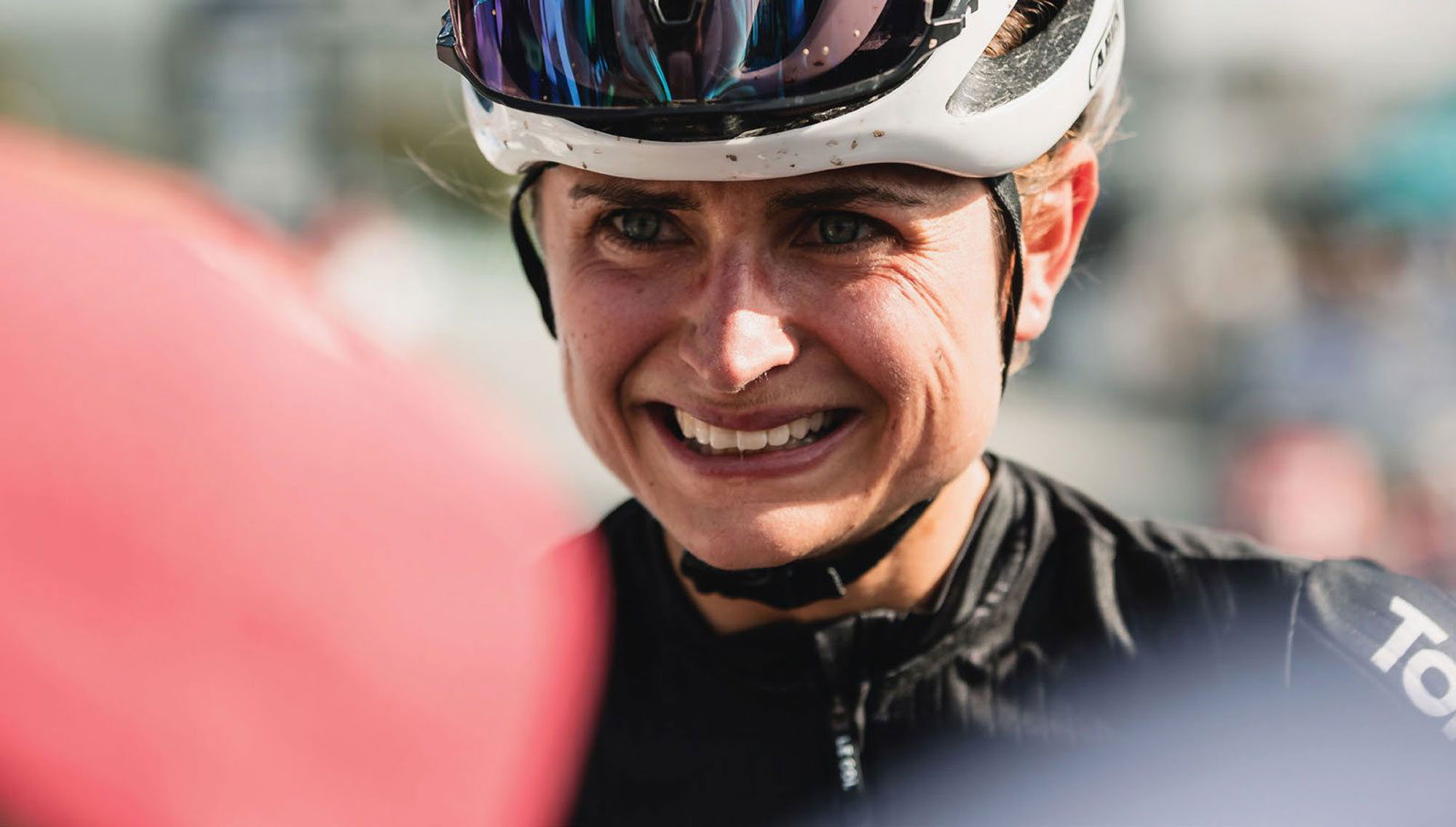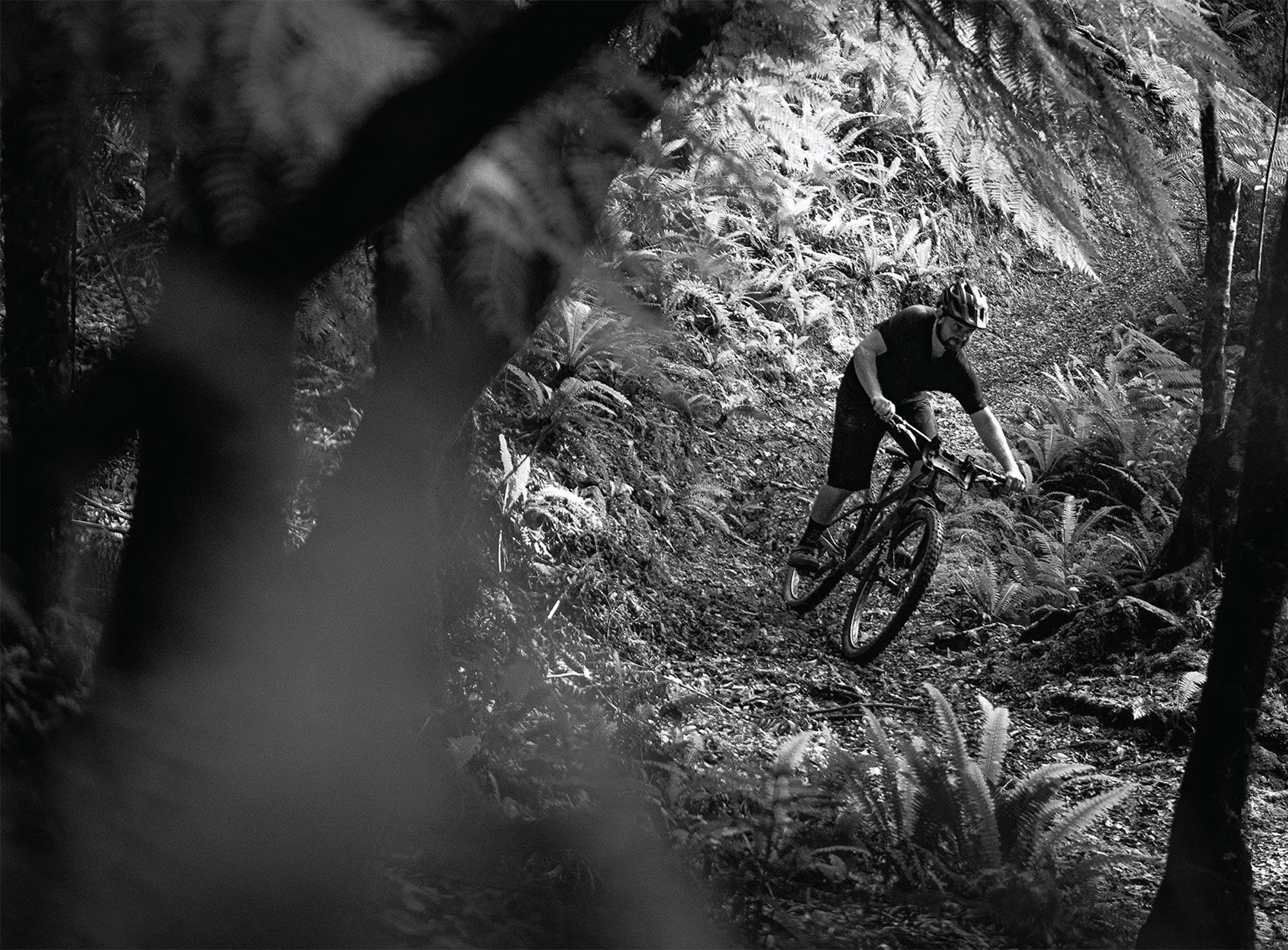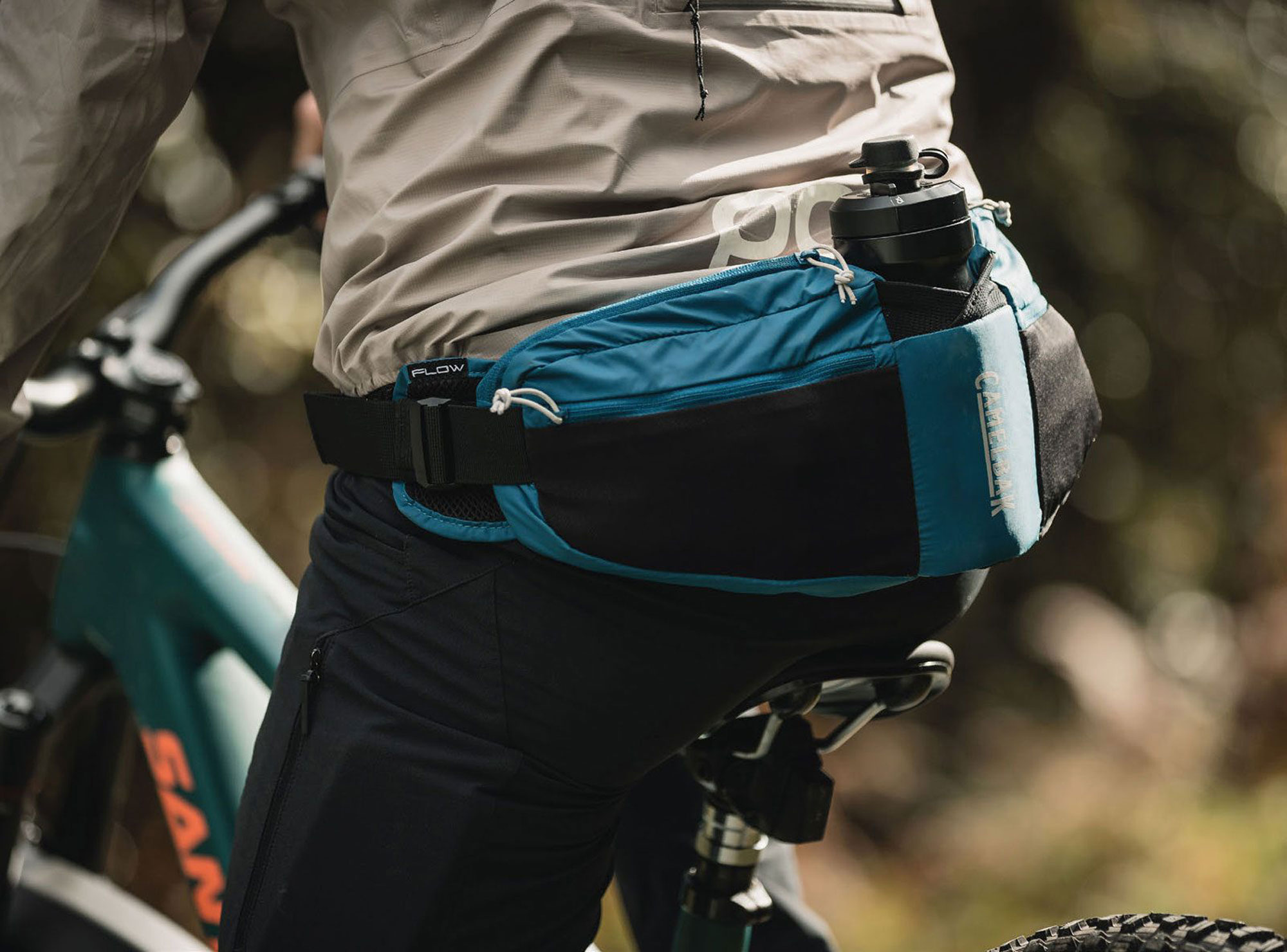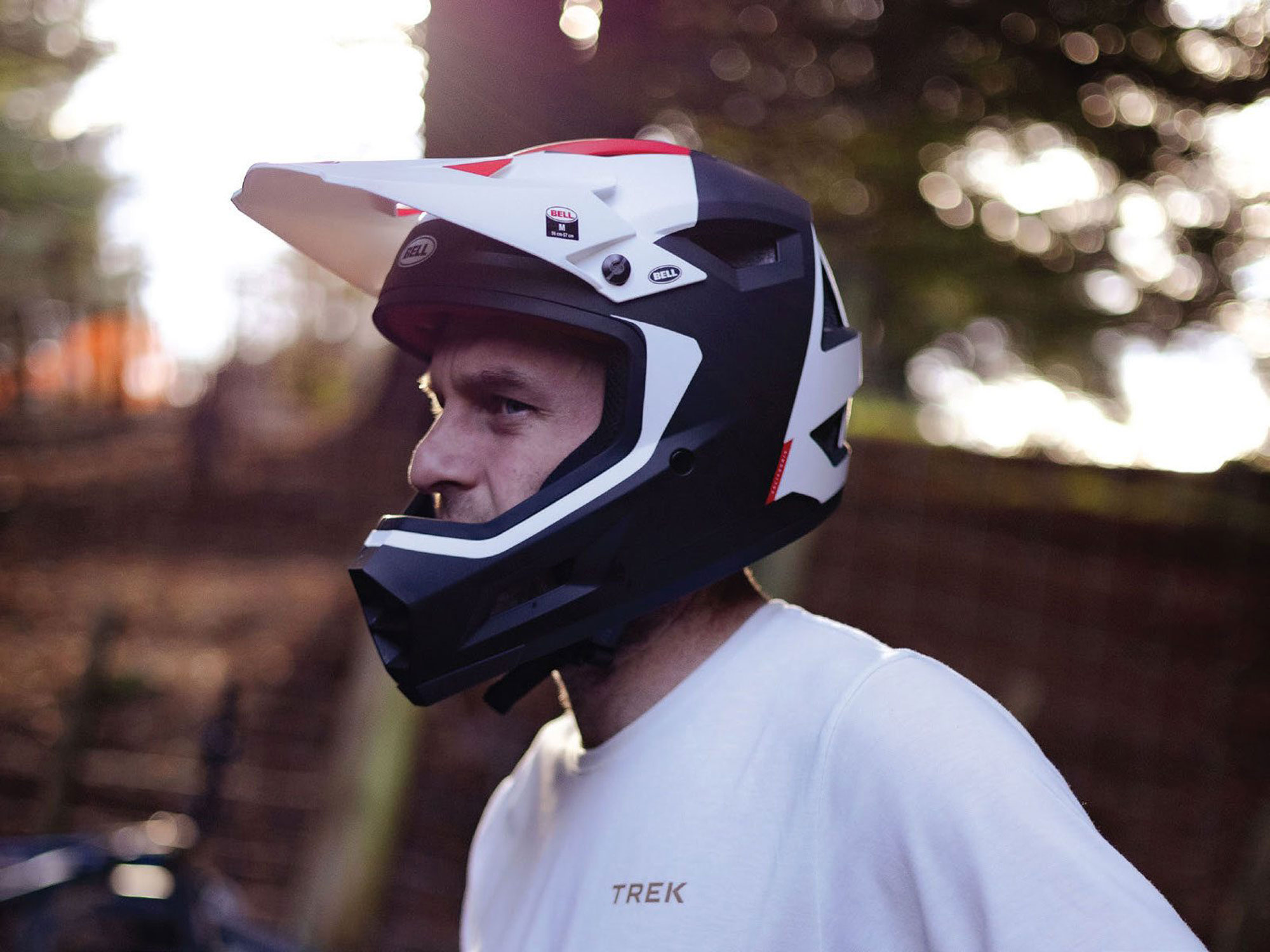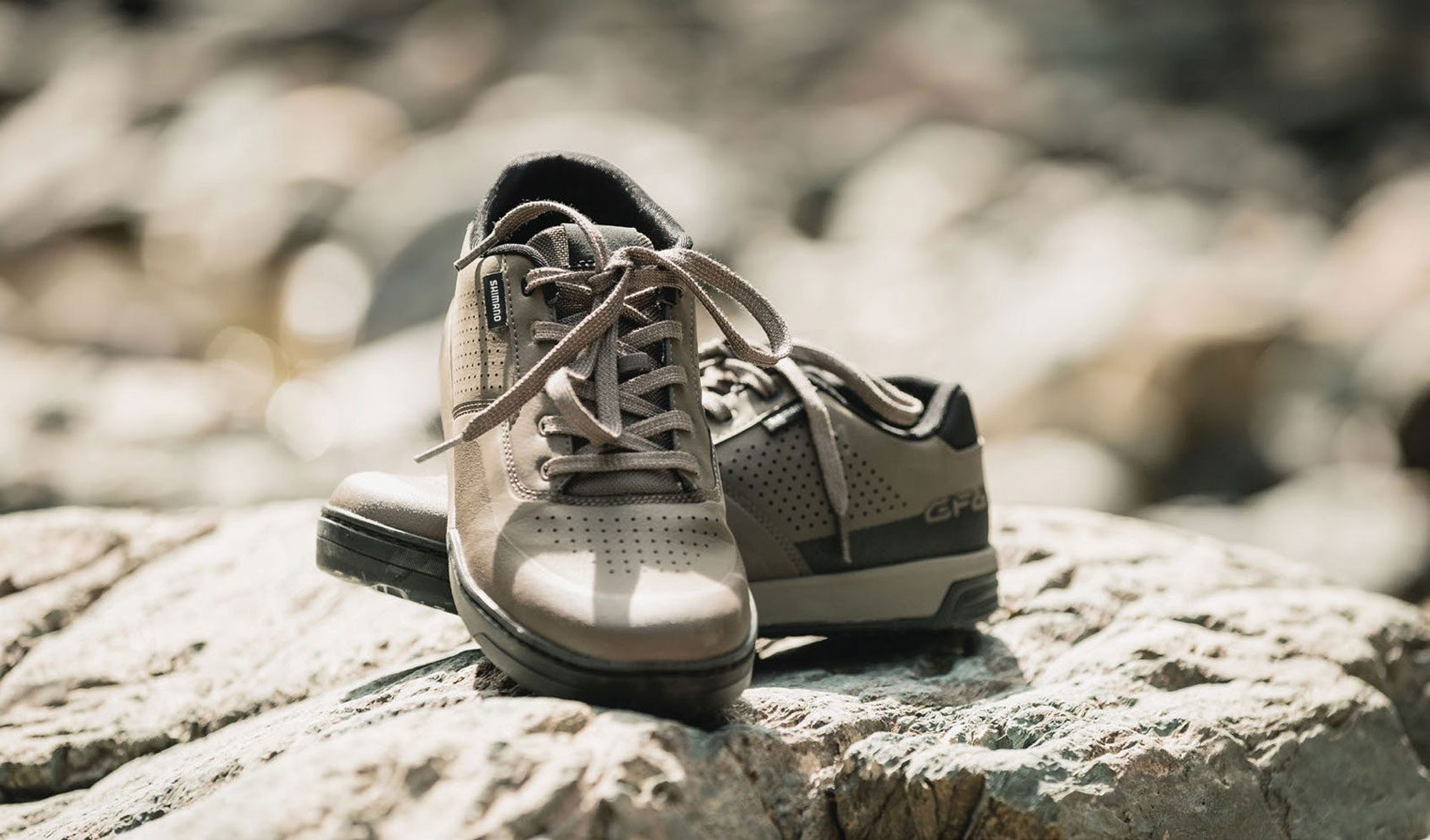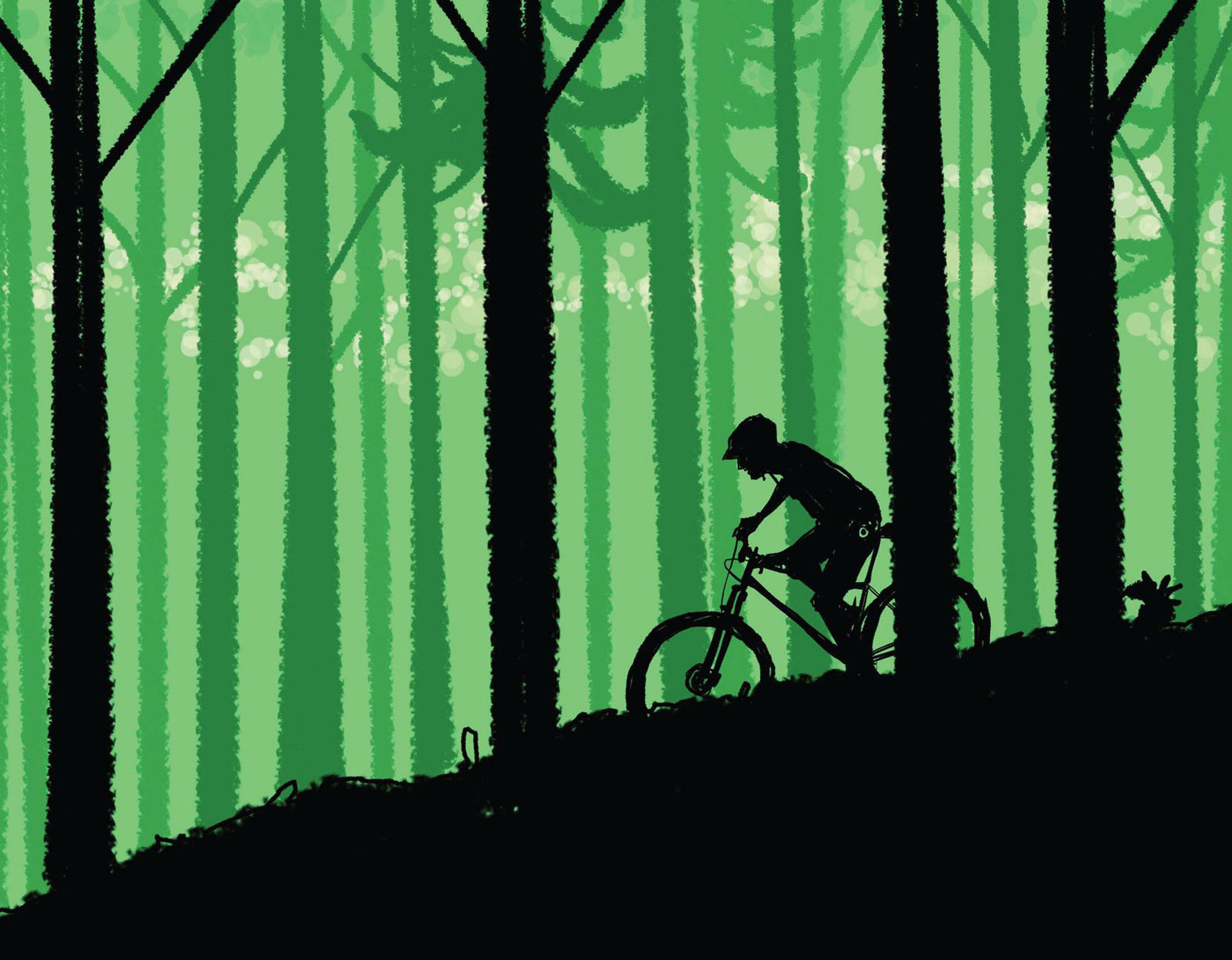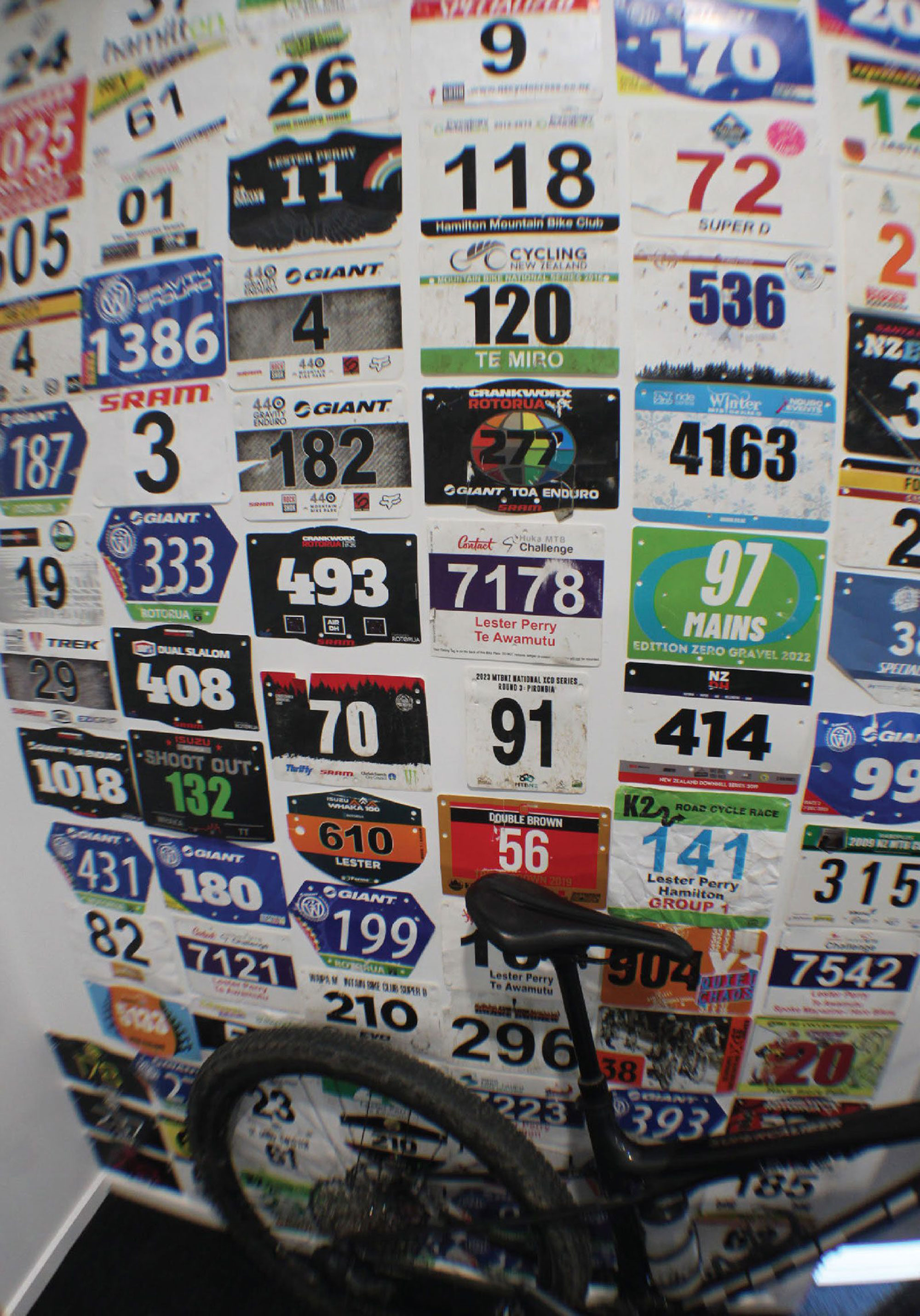Sammie Maxwell - Destined for greatness U23 UCI World Champion
Words Lester Perry
Images Cameron Mackenzie
Some would say XC is dead (they’re wrong) and others would say we’re seeing a worldwide XC Racing Resurgence. Word on the street is that livestream viewing figures for XC far surpass those of the downhill, and those tuning in are treated to action-packed racing across all categories at each round of the XC World Cup.
It’s been a long time since we’ve seen a Kiwi XC racer hit the World Cup scene with the impact of Sammie Maxwell. She first appeared on most casual fans’ radars at the beginning of the 2023 season, and they’ve seen her climb the ranks, race after race, to become the World Under 23 champion for 2023, and finish the World Cup Series in 3rd.
Anyone who has been immersed in the sport for the last few years, particularly here at home in NZ will know Sammie didn’t just burst onto the scene in 2023 but has been on this path for a few years. What has brought her to where she is now -a World Champion and a strong contender for an overall World Cup title? We were fortunate enough to dig a bit deeper into what makes this fun-loving, small-town girl with a huge grin tick!
Although not from a particularly sporty family, living in Taupo – just minutes from the lake – an active lifestyle is more or less a prerequisite. Although studious and high-achieving at school, early life was so much more than study and learning. The freedom and flexibility Sammie’s environment offered meant that netball, trampolining, running, Pilates, triathlon, football, swimming, cycling, rock climbing, horse riding and more, were regulars on her to-do list, although she was equally happy to lie in a hammock and read a book. Anything that required energy or had an aspect of competition and Sammie was sure to be front and centre!
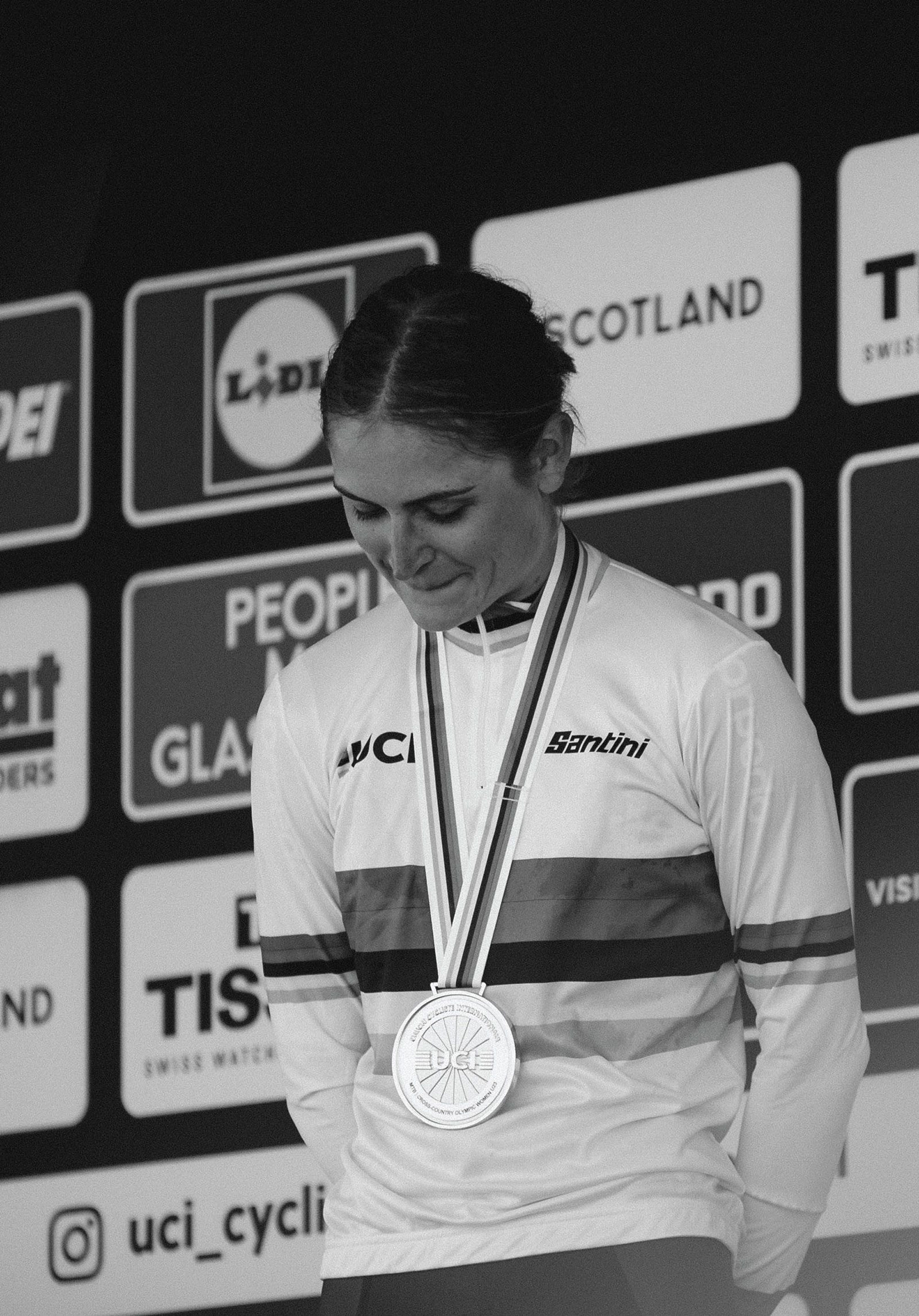
“I stayed in Taupo throughout all my schooling and certainly consider myself a ‘small town’ girl. I would enjoy the odd trip to the Mount with my grandparents where we would go to malls, etc but after a few days, the traffic and the shops would all lose their ‘exciting’ factor, and I’d much rather have the quiet Taupo streets!”
It’s commonplace for high-performing female athletes to excel in most areas of their lives, and Sammie is no different, slotting right into this stereotype. Throughout the early years, her inquisitive mind and passion for learning were continually stimulated by her parents; both high performers in their fields -her father an engineer, and her mother a laboratory phlebotomist. For years, Christmas gifts included books about biology and physics. A consistent top performer in her academic group throughout college, Sammie was awarded DUX in her final year. “In year nine, when our biology teacher gave us an assignment on a disease, we could pick whichever we wanted, and just research about it. I chose chickenpox because I had recently had Shingles (both caused by the varicella-zoster virus -Ed.). Being my typical curious self, instead of just reading a few lines of Wikipedia and calling it a day, when I got home from school that afternoon, I went straight to our massive bookshelf and got the five biggest medical textbooks mum had used while doing her study. I read everything I could about the virus, the immune system, the physiology of the disease and treatments. I became obsessed with the amazing ability of the immune system and knew from that moment on that I wanted to work with biomedical science.
“It’s fair to say that my teacher also agreed when the feedback for my report read something like: “Sammie, I asked for a college assignment, not something that looks like an abstract out of a university thesis”.
Sammie’s competitive nature spurred her toward mountain biking. “My brother and dad would go riding and I guess I wanted to be like them and join their adventures. I loved being ‘tough’ with the boys. When I was young, I would always be throwing myself into things my brother was doing – to try to impress him I guess. My dad would always buy us a McDonald’s ice cream after riding, and who was going to turn down a bribe like that!”
Alongside MTB rides with her family, Sammie picked up triathlon, meaning time spent road cycling. But she knew MTB was really where her heart was, even in those early years. “I love both types of riding and the road and MTB community in Taupo is so amazing, I really am lucky to have been involved in both; however, I always knew that when it came to racing, MTB was what I was best at and what I wanted to do.”
Sammie’s enthusiasm for all things biomedical science, and keenness for mathematics, led her to study a Bachelor of Biomedical Science, moving to Wellington to study at Victoria University. She graduated in 2022 with a Bachelor of Biomedical Science Majoring in Molecular Pathology.
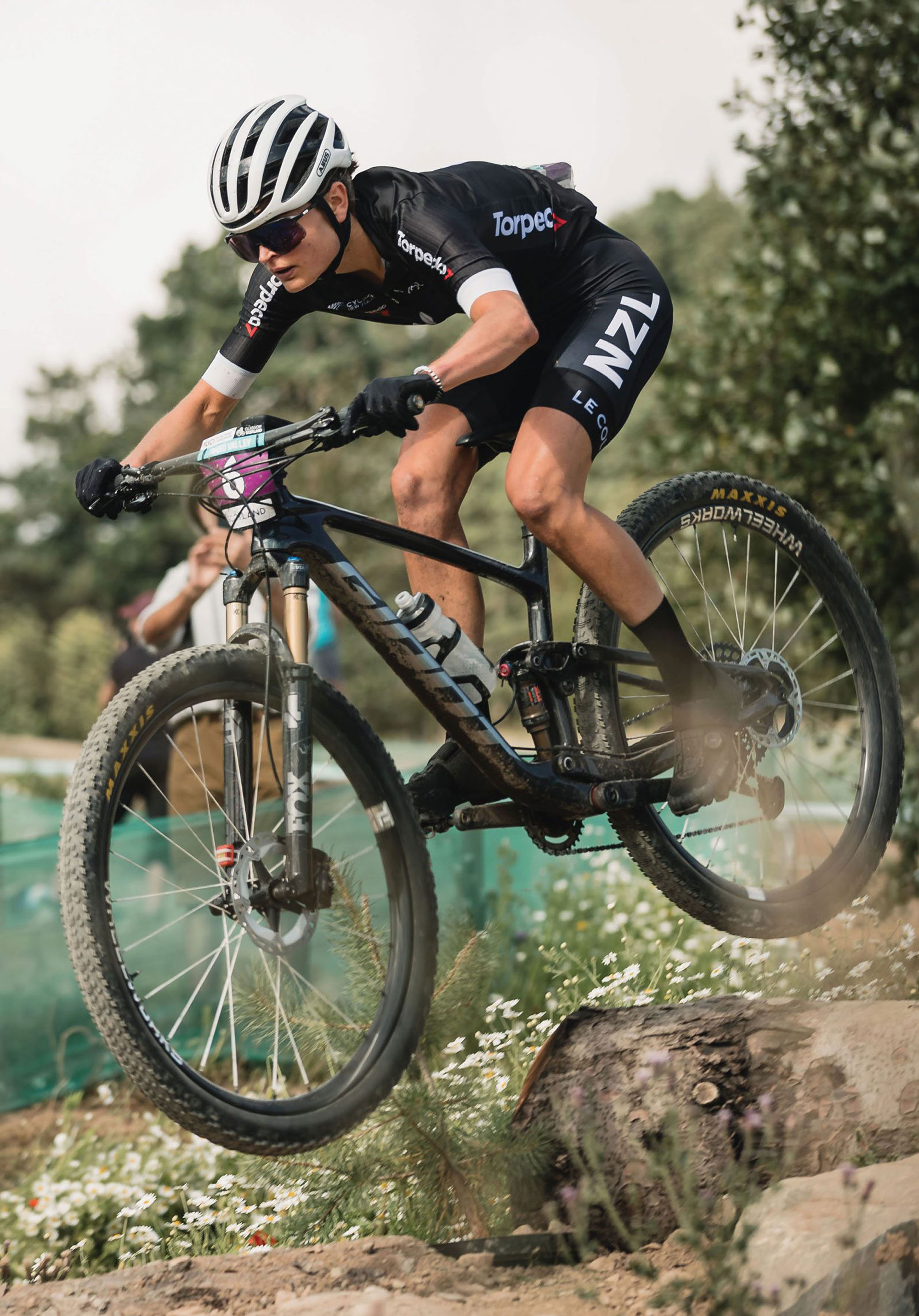
While training her intellect at university, Sammie was finetuning her racing craft on the bike, building the engine that has since lead to her success. Balancing a demanding study schedule with a strict training regime is a tough challenge and many an athlete has cracked under the pressure. Sammy powered through and, after graduating, began working in a research lab specialising in mRNA therapies and neurological disease research. She has a bit of a Clark Kent vs Superman vibe; outside of work life revolves around her training, but a quick change of costume, donning a lab coat, and she’s all business. “I have had my fair share of 5am wake-ups for training, and working until 8pm to fit everything in,” explains Sammie.
“I am lucky to have a great group of supportive people around me who can identify when I’m running low on energy (sometimes running on cortisol alone!) and remind me to take a break -often meaning dialling back the training a bit until the energy catches up. It’s hard work and definitely not something I could do all year around, but in the few months before heading for Europe, it’s nice to do one last push of mahi to remind myself how tough the ‘real world’ can be before jetting off to frolic around Europe for summer with my bike. It makes me very grateful when I am in Europe, and has taught me some intense work ethic which I pride myself on. In Europe when I have a big training day, I always remind myself I still have it easy – I could be in NZ doing that ride in the cold rain, in the pitch black at 6am – giving me an energy boost and making getting out the door a bit easier.”
All the hard work is now reaping rewards, but it’s been a long journey. Sam Thompson has been working with Sammie for five years, since pre-Covid times – first through the CyclingNZ Performance Hub but, after its demise, through the NZ MTB Academy. “We saw riders like Sammie prosper and develop exceptionally well under the MTB Performance Hub programme. When that was shut down there was a real gap in the development support network that needed to be filled. The NZ MTB Academy makes it possible to provide these athletes with professional support (coaching, sport science, strength and conditioning), professional guidance and also some financial support, to help bridge the gap from amateur to professional, and then also support them when they reach that professional space as well.”
In 2019, Sammie attended her first World Champs, in the Junior category, gaining useful experience and finishing in 14th. With racing on pause through the Covid period, Sammie used her time to address some issues which were hampering her success. “I have struggled with under-fuelling for a long time and spent a lot of time during Covid working with an Eating Disorder specialist, and psychologists, to get on top of this. So this year (‘23), when I showed up to Europe, I had a lot more maturity and was ready to start racing and recovering like a pro, to get through the season without fading.”
It wasn’t until 2022 that we saw Sammie start to settle into her groove on the world stage; the hard work of the previous years starting to pay off. It’s obvious from her results at the two world cups she raced in 2022 that her build to the top began back then, and was only exacerbated heading towards the 2023 season thanks to her methodical training and self-belief.
Coach Sam commented; “What stands out from others is her ability and belief to never give up, and her consistency of training. I would have trouble finding a session in the last five years that Sammie simply hasn’t done because she’s put it off. She simply doesn’t miss a session.”
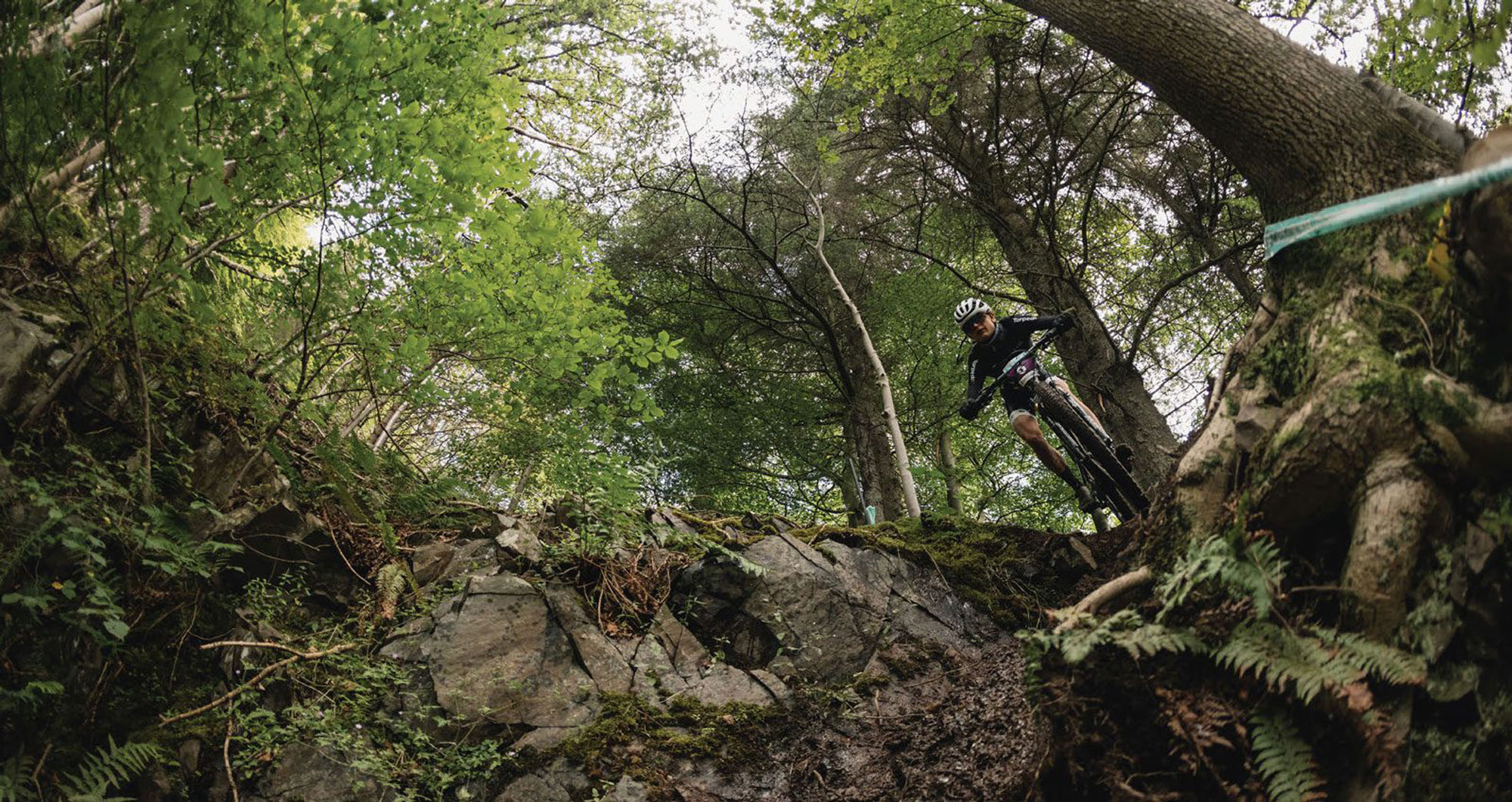
Trusting the process appears to be one of the keys to Sammie’s progress. The 2023 season has shown a consistent build right from back in May at the World Cup opener in Nove Mesto where she finished 8th.
“It was always the plan to not hit the season at peak form – especially since this is my first full season, and we didn’t know how my body would react. So we decided to start a bit slower and use the first few WC races as ‘form builders’ to introduce the intensity needed for racing. It was part of the plan to let the form physically improve through the season – but I think the biggest change was just gaining confidence in my ability and working my way through the starting grid.”
Following Nove Mesto, a month later, the World Cup circus headed to Lenzerheide, Switzerland. A confidence-building 6th place for Sammie and a solid build towards Leogang where we’d see a major breakout performance, with a 2nd place in the XCO after a tough Short Track (XCC) race to open the weekend. Two weeks later things were beginning to click in the XCC and Sammie crossed the line in 4th, the perfect primer for the XCO three days later. Another strong ride and into second at the XCO at Val Di Sole. Confidence, experience and physical form were all coming to a head just in time to peak for her season goal: the World Championships in Glentress, Scotland Then, on the 12th of August, Samara Maxwell became U23 Women XCO World Champion! After a dominant ride, distancing the field on the first climb, she eventually crossed the line draped in a New Zealand flag, having made history; the first Kiwi woman to win a Cross-Country world championship.
“In the days leading up to Worlds we had made a minor suspension change, but everything else was pretty much the same. I think just steady training for a few weeks with some good days over the local ‘cols’ and riding with Ben Oliver helped a lot; I accumulated stress on the bike but Sam (coach) and I were also watching closely because we knew the worst thing we could do would be to accumulate too much fatigue and dig myself into a hole before the event which can easily happen during pinnacle points in the season.
“I was lucky also to have the help of Louis Hamilton in Scotland; he showed me the best lines to take on the course and, as a privateer, this is something I don’t have access to at World Cups, so I owe a lot of my success on the day to him!” Sammie now had the spotlight firmly on her as she steamrolled into the remainder of the season. Heads were turned and everyone wanted some time with the “fresh face” in the pits, who they’d seen grow and develop quickly through the early season. Her secret was out and she thrived on meeting and chatting with so many new people who were discovering this fun- loving, Kiwi world champion for the first time.
“The people are amazing, and the sport is growing so much -it’s awesome! Changes to broadcasting this year allow people back home to watch my races and that’s helped increase the number of people following the sport and created a very exciting atmosphere at events. The girls I race with are amazing and I’ve met some amazing friends this year -I am just so excited to watch this sport develop over the next few years!”
Prime conditions and a strong race in the XCC rewarded her with second place at the opener in Pal Arinsal, Andorra. Sammie’s first outing in the XCO World Champs stripes would come a couple of days later, and in the toughest conditions of the season so far. The venue was hit with storms in the hours leading up to racing, forcing schedule changes (meaning no live feed) and leaving the course sodden and slippery. The form was there but conditions -and the venue being at over 2000m elevation –meant Sammie couldn’t unleash what was required to be back on top, finishing a credible 4th place.
Les Gets was next on the calendar and another dominant display in the XCO where she effectively put her competition to the sword on each climb, putting the group under pressure every time the gradient tipped up. After multiple lead changes throughout the race, Sammie finally made it stick on lap three, taking the lead once and for all, and maintaining a 30-second lead. It wasn’t all said and done, however, and she narrowly avoided catastrophe; crashing on a grassy off-cambered corner in the closing minutes of the race. Fortunately, her gap to second place was enough, and she limited her losses to cross the line with a stellar dance move finish line celebration and take her first World Cup win!
Never one to completely relax, Sammie has taken up learning French this season to keep her mind busy between racing and training. In years to come she’ll be getting plenty of French language practice, after a mid-September signing to high profile, French-based team, Rockrider Ford for the remaining 2023 races, and through until 2026.
“It’s been a dream ever since I can remember to be a professional cyclist. I’m beyond honoured to say, that thanks to Rockrider Ford Racing Team, this dream is finally a reality. I already feel so at home in this team and have had the biggest, warmest welcome. It only makes me more excited to see what we can achieve in the future together.”
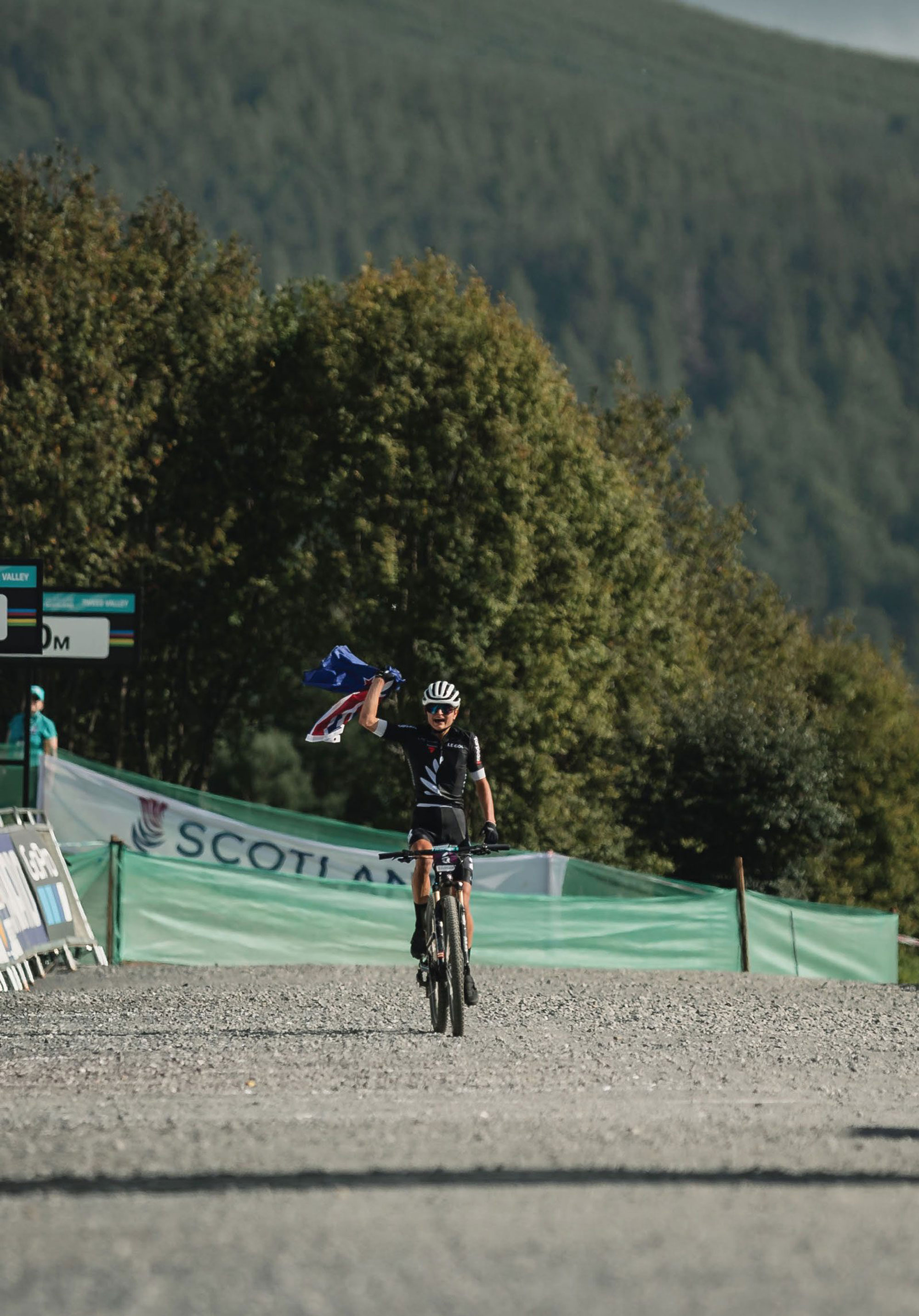
With all of the downsides of being a privateer now being taken care of, Sammie can focus solely on being a professional athlete, no longer stressing about having no income while racing across the world. With the mental load of finances and logistics now removed, preparations for next season are already underway. One of Sammie’s goals is to improve her technical descending, an area where she and her coach identified she’s been losing time to her competitors.
Sammie came out swinging at the debut race for her new team in Snowshoe, West Virginia for the XCC World Cup Round 7. Another solid race battling Ronja Blöchlinger for the win but narrowly missing out, finishing second. Snowshoe’s XCO race shaped up to be another epic battle with Blöchlinger, but this time it was Sammie who came out on top. It almost wasn’t to be though, and she narrowly avoided a huge crash on the opening lap, washing the front wheel out on greasy rocks and colliding with a tree, fortunately she stayed upright. Sammie put in a cracking ride, regaining her composure to go blow for blow with Blöchlinger in the early laps. Sammie continually pulled time on the climbs, and by the mid-point of the race had taken lead for the final time, growing the gap for the remaining laps to take the win by a minute, marking a perfect start with her new team.
Next up was a trip across the border to Mont-Sainte-Anne, Quebec, for the eighth and final race of the 2023 season. Blöchlinger rounded off her perfect XCC season with her eighth win, just pipping Sammie for the win again, and collecting valuable overall series points. The XCO race saw the toughest conditions of the season; rain had set in, making the technical course even more technical for even the most skilled riders, leaving them battling not only each other, but the conditions and course as well. At times, the race looked more like a duathlon than an XCO with most riders taking to running sections at times. Thanks in part to Stephan Tempier’s line coaching, Sammie rode the technical sections confidently.
“I was able to ride everything in the wet, even really tough sections that the elite were crashing on, so that was a huge positive. It meant I felt safe and confident and was able to have sooo much fun slipping and sliding my way past people!” Proving her mental resilience after a start loop flat tyre; she chipped away at the field for the entirety of the race, eventually finishing fifth, securing herself third place in the overall series and cementing herself as one of the world’s top XC riders. When asked about any wisdom she wished she had known earlier in her career, and what tips she’d pass on to other young women looking to break into the World Cup circuit, Sammy offered some clear advice:
“Never feel like you’ve got to make sacrifices or suffer unhealthily to succeed. In our heads, we often think elite athletes are insane people who have super-human abilities to suffer, and when it comes to physical training yes, they do suffer, but when it comes to their mentality, the top-of-the-top athletes protect their mental health above all else, and this is something that’s taken me a while to figure out. If our brain is unhappy or starved of the joy and energy it needs, we will never be able to perform at our true potential. So always make sure you are looking after your body and giving yourself the rest you deserve! Plus, eat the damn dessert! I spent too long turning down yummy foods because I thought it was what a real athlete would do – when in reality, ice cream is your superpower! “What it takes to win should be sustainable and enjoyable. You need to believe in yourself, and you can’t do that if you keep feeling like you are having to change the way you function or change what you want to do to succeed. It should come naturally. I can say I wasn’t acting any different for my lead into Scotland than I was during the middle of winter last year in NZ – once again it’s just a matter of trusting the process, loving what you do and enjoying yourself while you put in the work!”
No one gets to the top alone, and it takes a village to support an athlete as they work their way there. Sammie wanted to pass on a special thanks to all who’ve helped and supported her in this journey so far.
We’re excited to watch her develop and see where Sammie’s career takes her as she steps into Elite for the 2024 season. One thing’s for certain: that grin of hers will be showing up in race coverage for many years to come!
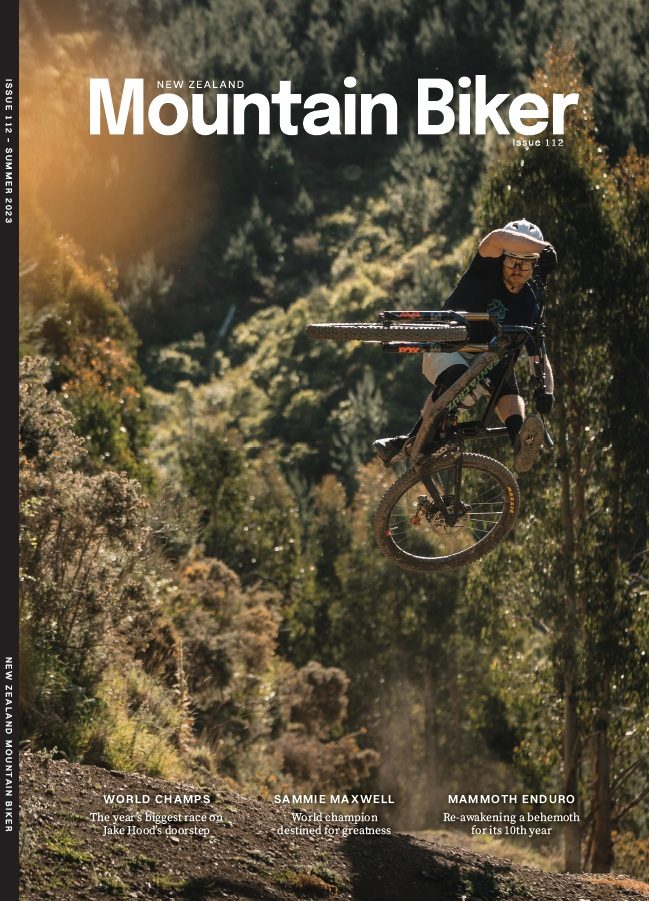
Royale with Cheese Part 2
Words & Images Jake Hood
Our day started early. We packed up all our stuff, and left behind the items We didn’t need to take up royal. then we set off. the morning started With a tiny bit of technical sWitchback trail, then an off-the-bike hike down a cliff to the riverbed below. the dirt Was a lot drier than the day before, Which Was a good thing because it seemed like the day was going to be technical.
We hit the riverbed, crossed a small stream, and reached the start of the Mt Royal walking track. To begin with, it was a bike-on-your-back approach -we were literally climbing up a cliff face with our bikes. The rock we walked on was covered with moss, and we had to think about where we were walking and where our next step would land us. Once we got past that point, it was just a pretty steep, relentless push for about an hour before it mellowed out. It was one of those hills that is steeper towards the bottom and mellows the further you go up. The soil changed as well. It was pretty clay-like at the bottom, very slippery in the wet. The further up we got, the less present the clay was in the soil, giving it a more predictable nature. The foliage and cornflakes (some might say ‘loam’) that covered the trail seemed to get thicker as we gained more altitude. You could tell this trail wasn’t used that often; it wasn’t a worn-in, obvious track like many of the others in the area. There were a few times we lost the track on the way up. The trees were spaced pretty far apart, leaving heaps of space to hold it wide open on the way down. The trail wiggled its way up the mountain, covered in a spiderweb of root gardens. Some of them had huge roots that created large steps to get over, potentially causing a wheel stopper or going over the bars. I later found out this was the case.
Near the top, we stopped for a spot of lunch. I think we’d have been pushing up for about three hours or so by that point. It was pretty hard going. We stopped at a beautiful little opening in the trees that gave us a great view of the Richmond range. Mt Fishtail lay just before us. What a mountain that was. Lunch chat consisted of more talking shit about Bradshaw almost bailing and how good the DB Draught was going to be at the pub that evening. You could see the top of Royal from the spot. We had to descend along a ridge for a little bit before the final push up into the rocky alpine. It was going to be about an hour to the top.
It wasn’t long, though, before the chat ended up beIng about cold frothy beers and food at the pub later on. how good were those beers going to be?
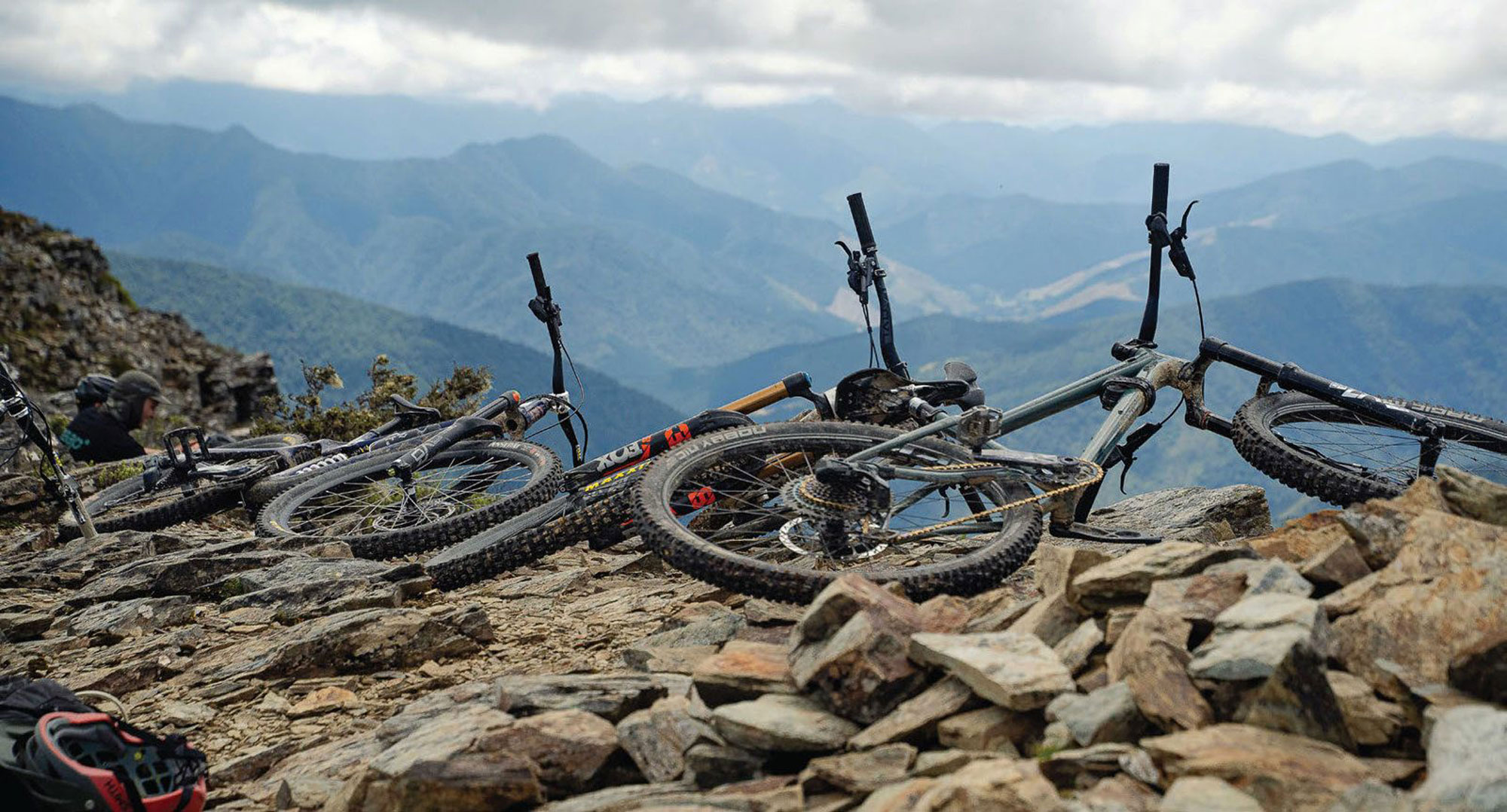
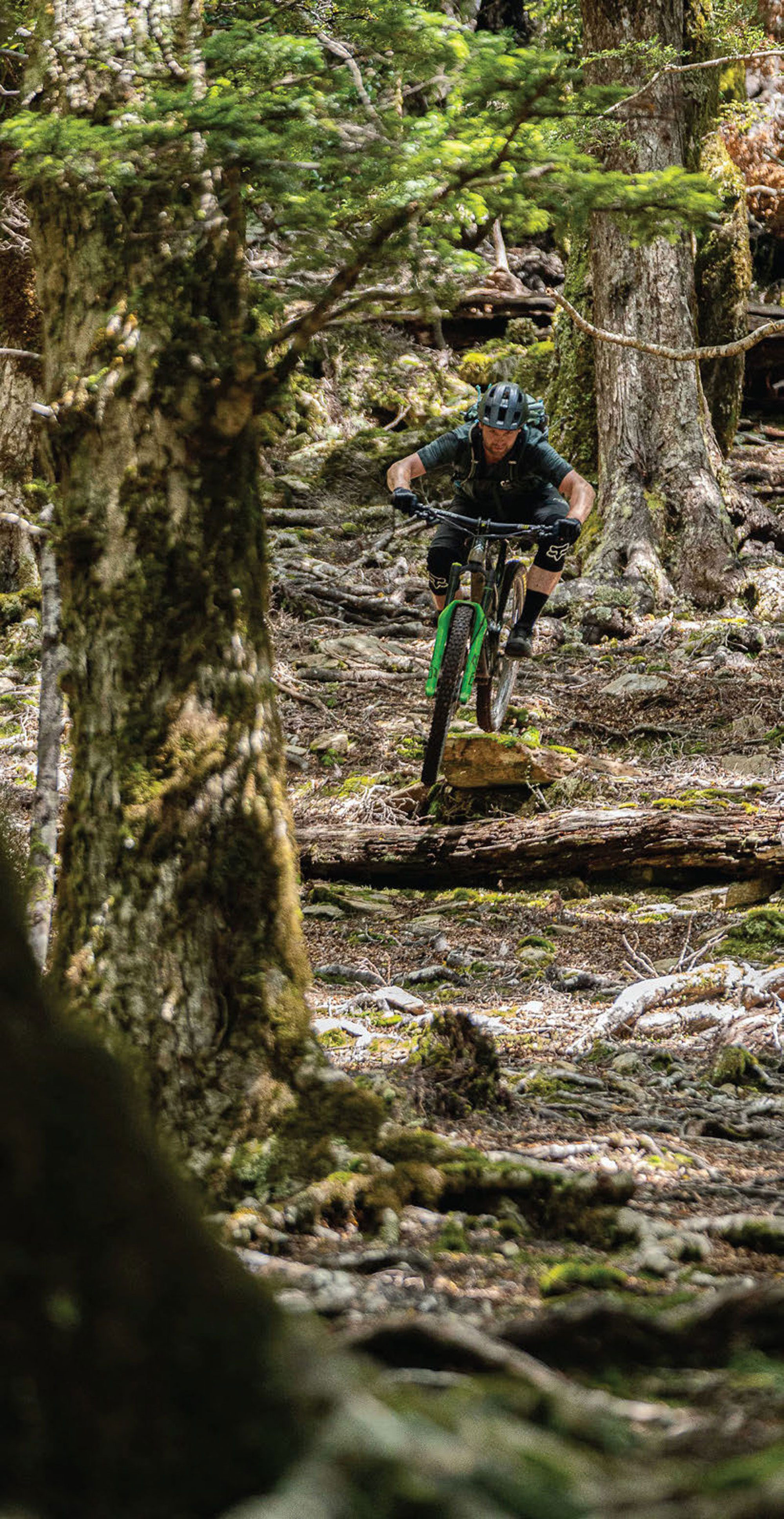
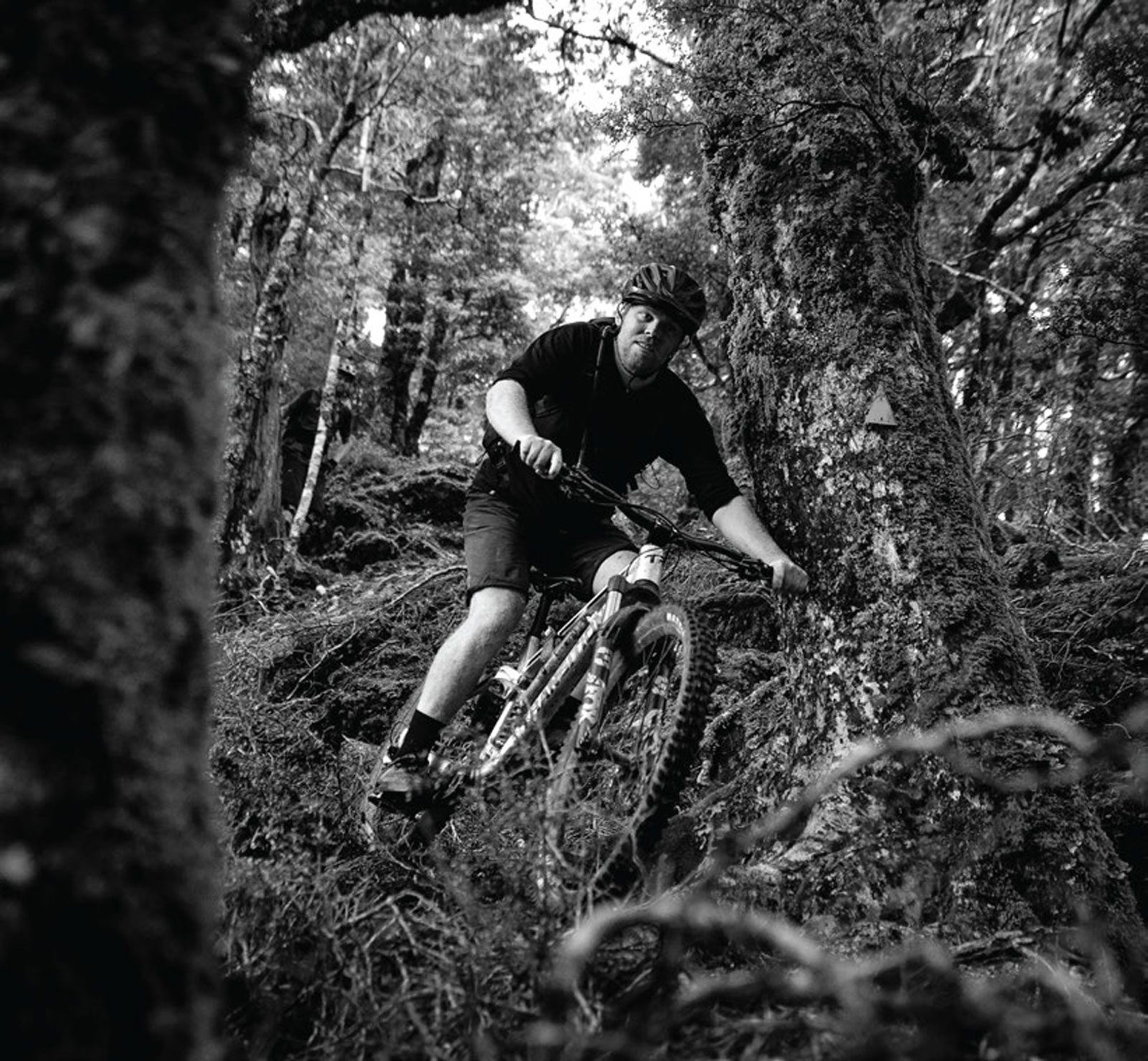
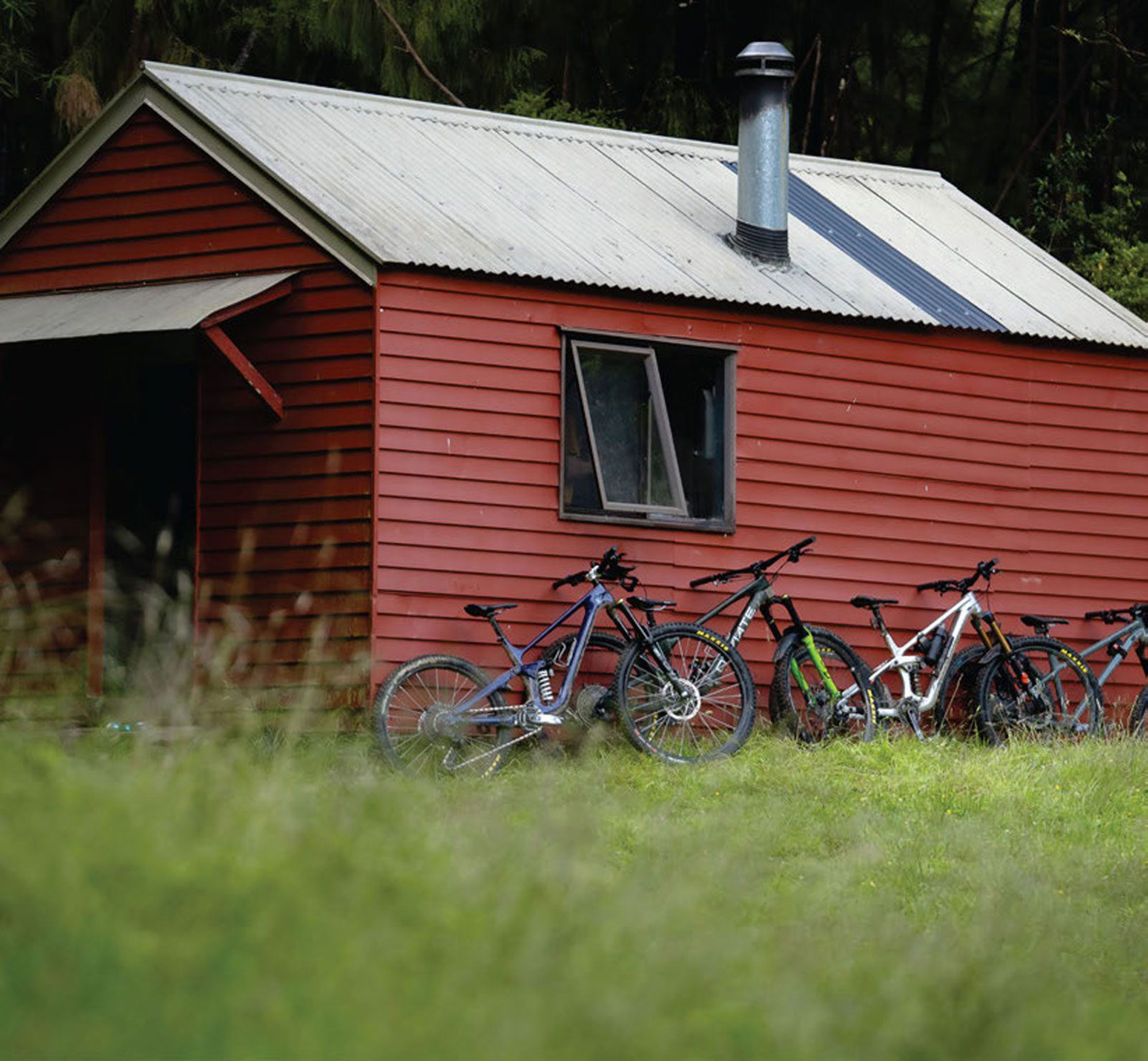
No one wanted to descend the ridge first; it was pretty damn steep -and none of us knew how slippery it was going to be. The track sort of just disappeared, and it was a bit of a pick-your-way-down, trying to find places where you could get some good braking in. Turns out that going first was probably the best option, though. The locked rear wheel scraped off all the good foliage to brake on, and left behind slick black sludge. If you locked the front brake on this, you would know about it – but it was fun to pick our way down.
As we pushed up the last stretch, the trees started to thin out and the trail was more defined from here through the rock and scrub -nature hadn’t taken back the track like lower down. It was a bike-on-the-back hike up through the loose big rocks and some nice big bits of slab which made up the trail. My legs were starting to feel numb and heavy on the very last bit of the push; that pre-bonk feeling. Thank God the top was close. As we rounded the final bit of the mountain to the summit, the wind started to howl. It was strong, and our bikes acted like sails in it. The last stretch was a small walk along the flat to the top. Woohoo! We had made it to the summit of Mt Royal.
It was a clear day, and you could see for miles. There was a blue haze over all the hills. To the west, Mt Fishtail basked in the sun above the rest of the Richmond Range. To the east, you could see Blenheim, the Cook Strait, and the very faint outline of the Wellington coastline. The 360-degree views were stunning and the endorphins were kicking in – that high you get from reaching a summit. High-fives and hugs were thrown about, with smiles all around. These are the moments we do this for. Well, that and the fact we had a flipping awesome descent back down to the hut ahead of us. The howling wind was pretty chilly, so we chucked on some layers and found shelter just off the top, behind some rocks, to enjoy the view for a bit before we headed back down. You have to savor these things.
The trail eventually led to the point where we had to get off and hike back up to the lunch spot. From there, it was all downhill back to the river. What a time to be alive.
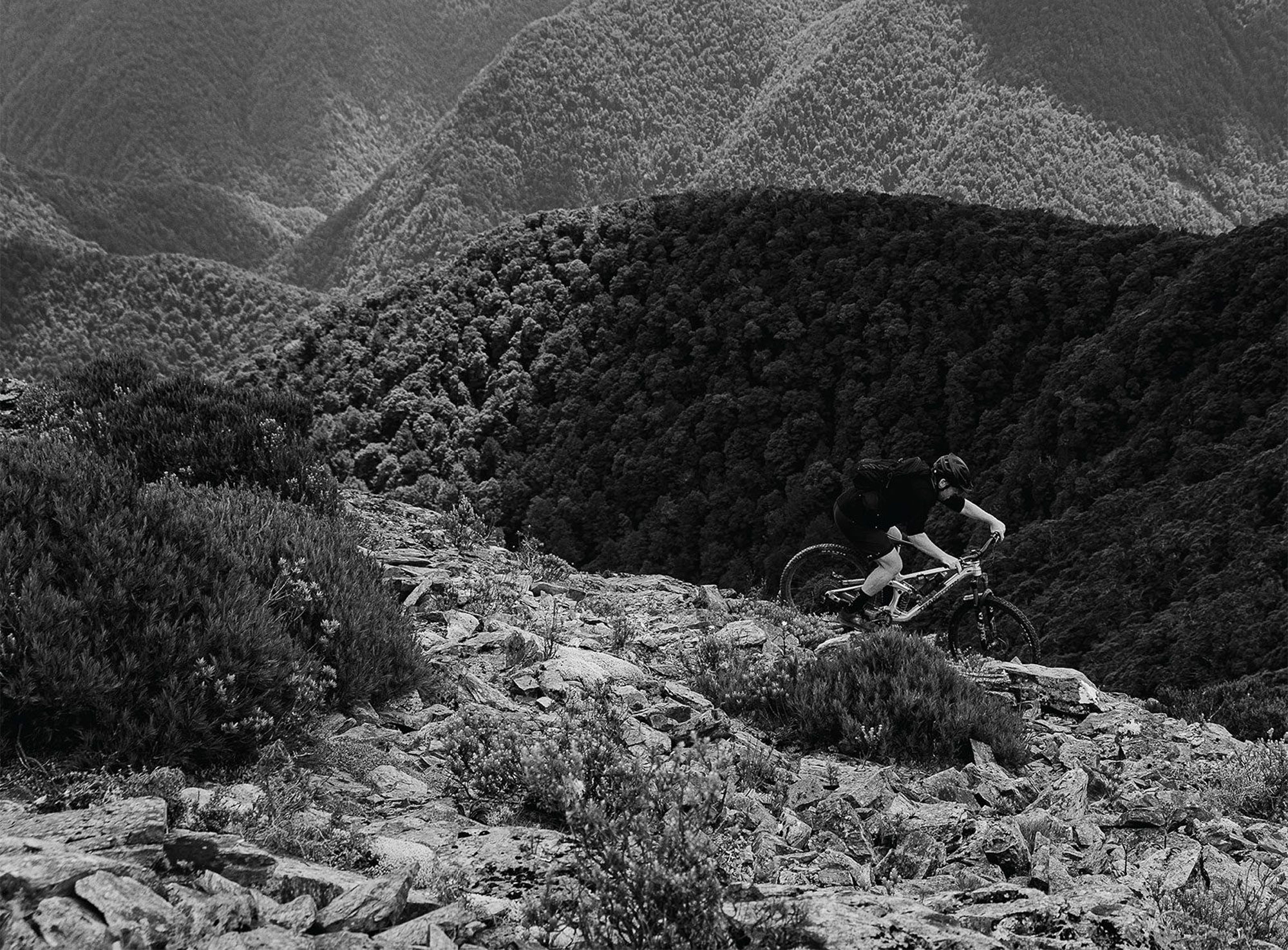
It wasn’t long, though, before the chat ended up being about cold frothy beers and food at the pub later on. How good were those beers going to be? This thought quickly prompted us to get back on our bikes and start heading down. Off the top, you have to ride along the flat, leaning your bike into the side wind until you start tipping into the trail. Paul, Scotty, and Cappleman were keen beans and started attacking the rocky shale alpine. Big long rock slabs covered in wheel-sized cracks, with drops off them into foot-sized loose rocks that moved below your wheels, made up the track. There were a couple of switch-back turns which made it even more fun. The sound of the terrain moving below your wheels while your bike danced through the chunder was delightful. Bradshaw was making light work of it on his hardtail, with a massive smile on his face. As the vegetation started to appear, the surface became more gravel-like, and the trail became more defined. Scotty, Paul, and Cappleman were off on a mission. The trail flowed along the ridgeline, turning left and right through the scrub. It had small undulations that you could use to pump or pop off. The surface was soft and gravel-like with some rocks and cornflakes mixed in. My bike felt amazing -the suspension was just fluttering along through this stuff, tires were hooking up a treat as I weighted the bike into the turns. You could feel the side knobs carving into the loose ground.
As the Beech forest thickened, the trail started to steepen. We stopped at this steep roll feature that we had looked at on the way up. It looked like a goer, and the way around looked pretty ugly. It was just a matter of if we would be able to stop after. How much speed would you pick up off of it? Would you be able to slow down before the turn into the next shoot? Paul tipped in first and greased it, making it look easier than it should have been. From there, we all hit it. It was a fun feature. In the dry, you could have hussed off it.
The trail eventually led to the point where we had to get off and hike back up to the lunch spot. From there, it was all downhill back to the river. What a time to be alive. The trail followed the ridge along for quite a while; not super steep, just enough of a gradient to keep the speed up without pedaling. The faint trail flows through Beech forest and is covered in deep, mossy foliage. The occasional fallen tree covered the track, but some logs had been placed in front of them, turning them into a feature to huck off. We whistled our way along the ridge, freeride flicks happening everywhere, foliage and sticks flying from the tires into the air. The bikes danced over the slippery roots and rocks that lay beneath. The trail would go from flat out to a few slower speed turns and back to flat out. There were whoops and hollers coming from everyone.
One ridge led to another, and things started to steepen up. Just off the ridge was where the trail took us. It was steep, covered in deep leaves. The trees were sparse, and turns in the trail were long and sweeping. This was my favorite bit of the trail. The dirt was super slick under the leaves, and you could drift around the turns with your foot off; opposite locking on the way in and letting the back wheel slide out on the way out. Just left, right, left, right. It was amazing. So much fun. I just could not wipe the smile off my face.
A second wind must have hit us because we started hitting it hard. the pace increase was insane. The pub wAsn’t far awAy; it was in sight, like a glowing beacon of happiness.
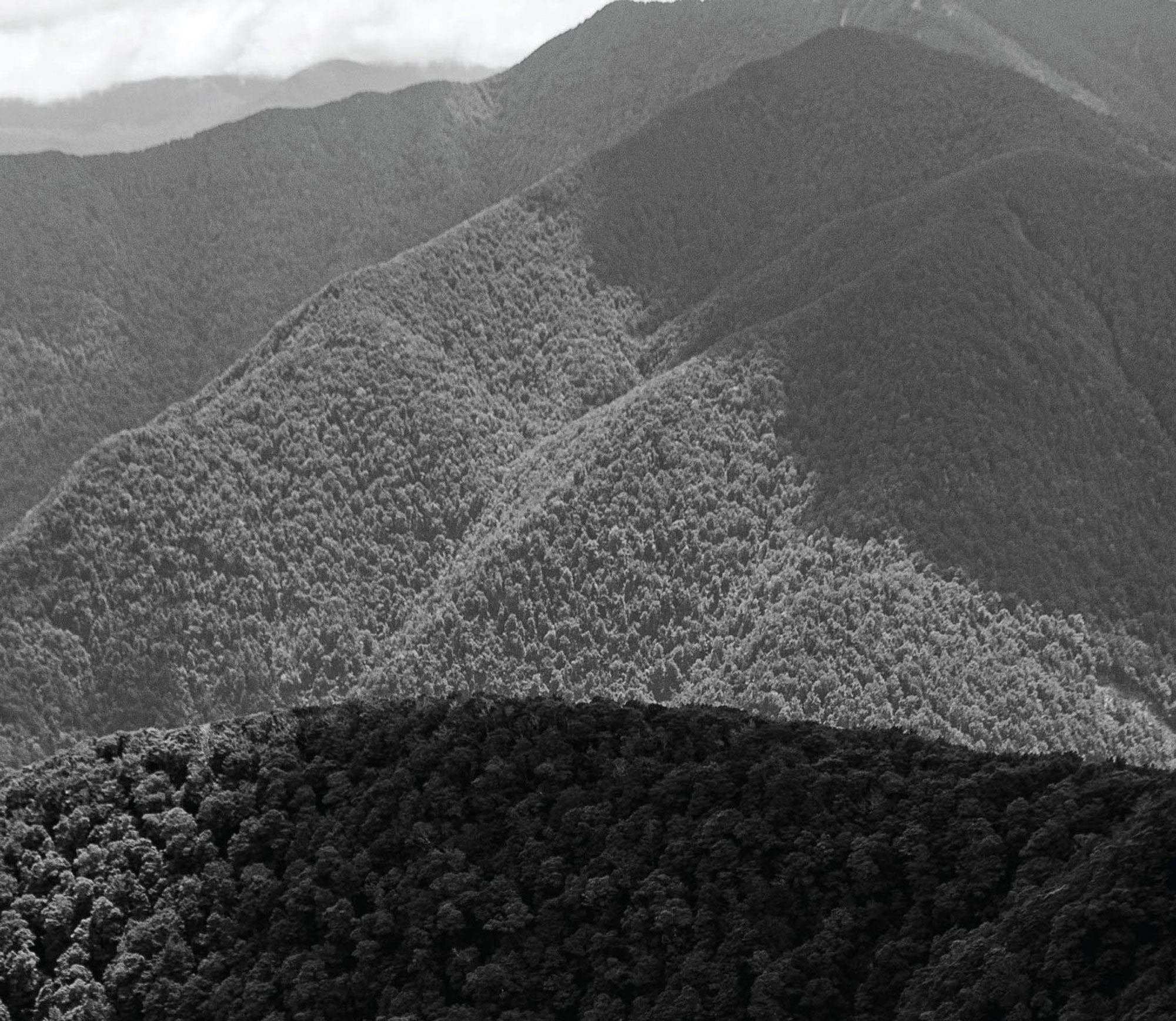
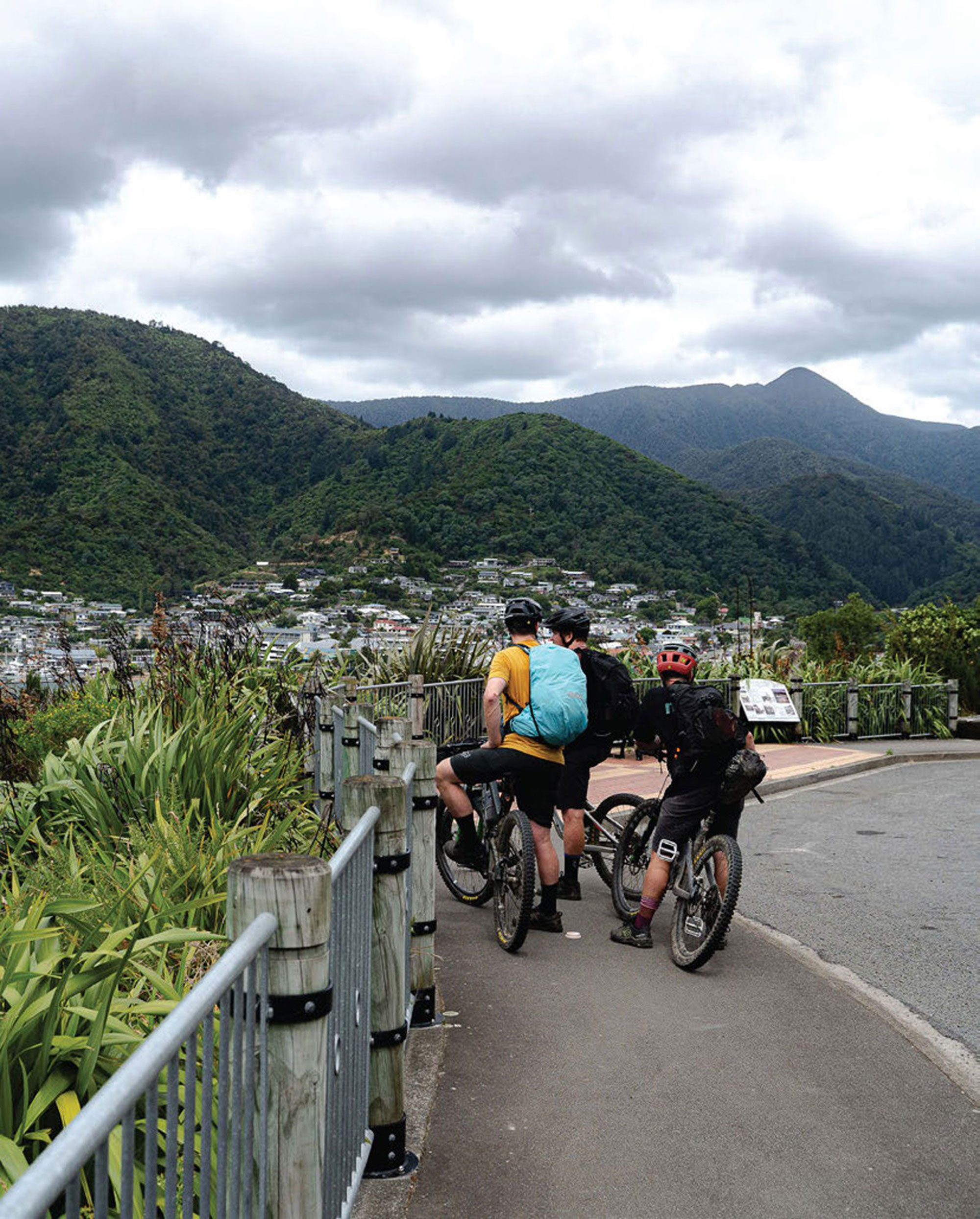
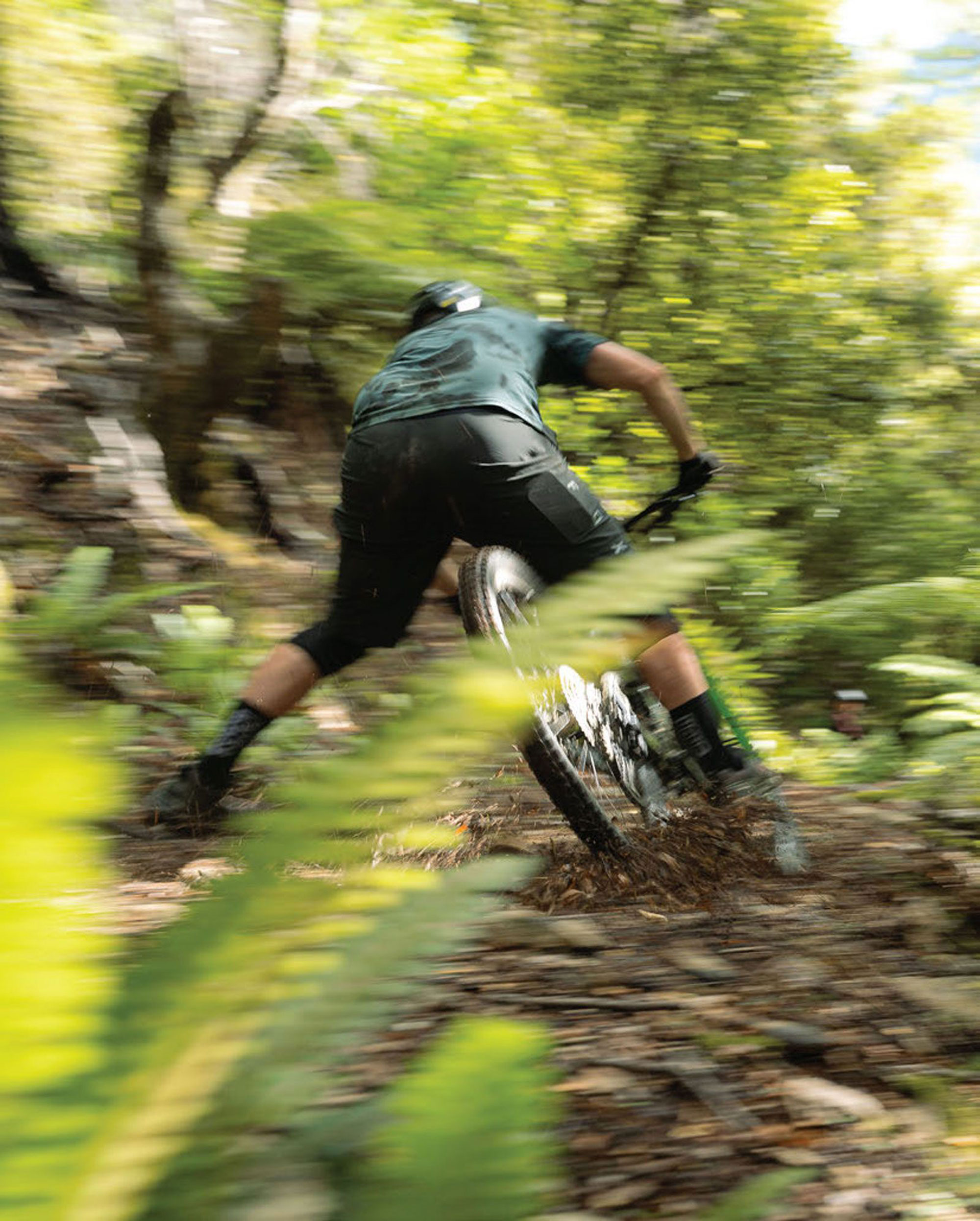
After that bit of speedway fun, the trail popped back out on the ridgeline. You then work your way through a long section of janky rocks, which meant travelling at a slower speed than what we had ridden so far. Thinking about lines was key: be precise. Momentum did help, but going at it full attack wasn’t going to end well. Personally, I love this stuff. It’s a challenge to ride. It takes skills, balance, and confidence to get you through.
After that bit of tech, you come off the ridge and back onto the face of the hill. It was a bit of a choose-your-own adventure at times since the track just disappeared at points. We were just pointing our bikes down the hill and following our noses till we found the trail again. Fallen sticks cracked and snapped under our wheels – it was a lot of fun. The further down the trail we got, the more technical it got, and the speed started to reduce. The huge wheel-trapping roots started to come out. You had to be on your game; think about your line, commit, and hold momentum through these. One of these wheel-trapping root sections caught me and sent me out the front door. Luckily, I was okay and landed in the soft foliage.
The steepest part was the last – and potentially the sketchiest – bit of trail. It got really steep, with huge steps into compressions. The dirt was clay, so grip was at an all-time minimum. We rode some of this, but the compressions were hard on the body, and you really had to find a flat platform to come to a stop to control your speed. The green, mossy clay dirt was doing its best to help the tire slip and slide. The bottom was so close, and you could see the riverbed…. and also the cliff you would ride off if it all went wrong. Sensibly, at this point, we decided to get off and hike down the last part. It just wasn’t worth the risk. I even managed to slip just pushing down, which resulted in my falling on my bike and bending the derailleur hanger. Shit. It wasn’t good. It looked fairly bent, but I would have to assess it back at the hut.
We scrambled down the last bit of cliff/trail to the riverbed. Fuck yeah. Royal was done. What a trail that was. Different from everything else I have ridden so far in the Richmond Range. It just had so much variety. It was wide and fast with some tech features mixed in, and less scary to ride than Fishtail or Riley. God, it’s amazing what you can do on modern mountain bikes these days. Bradshaw was the man of the match on his hardtail. What a guy.
We stopped for a quick look at the vieWpoint overlooking picton before We rode down the road into town, grabbing the bag of clean clothes We had stashed two days earlier out of the bushes. We had done it.
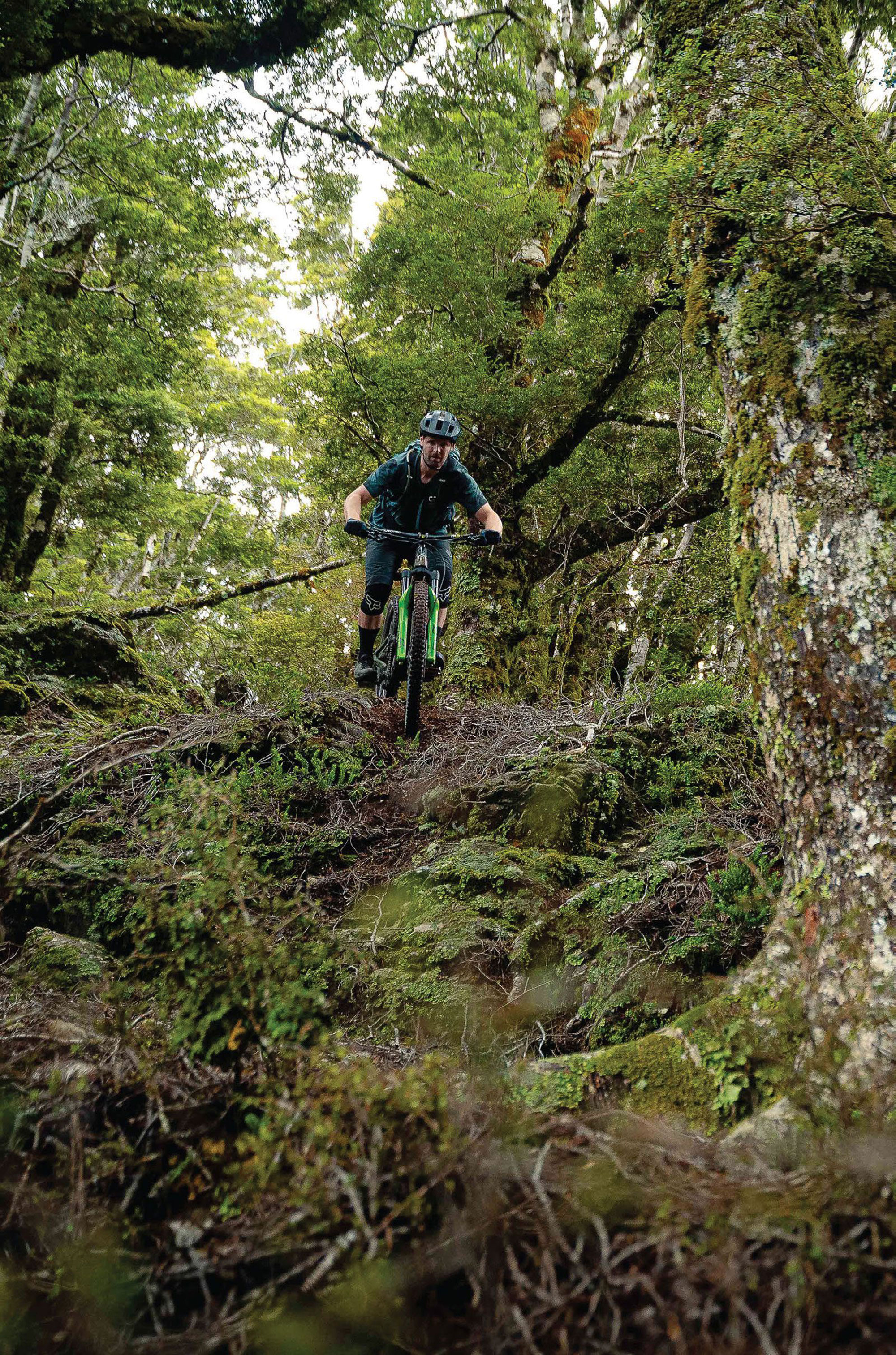
The day wasn’t over, though. We had to get back up to the hut, pack up and load up the bikes, then get out to the Canvastown pub. There were still a few hours of hard work ahead. We crossed back over the small river and scrambled our way back up the basically-a-cliff-face to camp.
“I’m glad you bullied me into coming up. That was fricking epic,” Bradshaw jokingly said. It really was. Back at the hut, we loaded up the bikes. Well, Scotty, Paul, Cappleman, and I did. Bradshaw instead decided that he was going to completely unpack everything and repack it all again, which might not sound funny but, when he’s doing it in his underwear (for some reason), flailing around like a wobbler in the long grass, which was very bee and wasp-populated, it made for some very entertaining watching. Especially every time he got stung. We were in stitches. “What are you doing?!” we yelled at him. After about 15 minutes, we got bored and headed off onto the trail out, as we didn’t want to get stung. It must have been another 15 or 20 minutes before Bradshaw joined us. Wobbler of the Week, right there.
Seven kilometres of trail lay ahead of us, back to Butcher Flat campground, then a 15km ride to the pub at Canvastown. By this point, we were all pretty tired and over it. The inevitable come down from the high was happening, and the next part was going to be a bit of a chore. It’s funny how many emotions you go through on these big days. As we headed back out on the trail, I could feel that my legs were pretty weak. The hiking up had taken it out of them. I had to walk the steep pinches in the trail as the bent hanger had taken away the ability to use the top gear. Amazingly, the rest of the gears were fine. I was going to have enough to get me back to Picton. The SRAM AXS is pretty damn great. I just got my head down and pushed through. It wasn’t a super fun trail to ride out, more of a means of getting somewhere but, after about an hour, we arrived at the road back to Canvastown. The pumps got wiped out. Tires inflated to near maximum PSI for extra rolling speed. Time to grind this road out.
Something must have come over Paul and Cappleman because they decided to set off at a blistering pace, leaving the rest of us behind. I had my headphones in, listening to a podcast, and sort of just hit the road at my own pace, spinning up the climbs and pushing a bigger gear on the flats. Scott and Bradshaw were a little ways behind on the road. I think their legs were dead. I just got my head down, zoned into the podcast, and spun away. I made sure to enjoy the place I was in. This valley reminded me of my home back in Scotland; very green, lots of farmland, and pine tree forests. Having ridden the road the day before, there were certain landmarks I recognised, giving me an idea of how far to go. Boy, I was excited for a beer at the pub after this big day. As I passed Bradshaw’s grandparent’s hut, I knew it wasn’t far – just 2km or so. By this point, Scotty and Bradshaw had caught me up, and we got in a chain gang. A second wind must have hit us because we started hitting it hard. The pace increase was insane. The pub wasn’t far away; it was in sight, like a glowing beacon of happiness.
The bikes got parked up. Paul and Cappleman had found a good seat and were already on the beers. DB Draught was the only real choice. Now, I’m a bit of a beer snob, but there is something great about a cold DB Draught after a big day. I think it’s just made even better by the fact you’re drinking it in this old, rural pub. The pub had recently been taken over by new owners, and the place was pumping with regulars. It had a very homely feeling. Somewhere you could just settle in for a big shift, and that’s exactly what Paul was doing. The man was putting them away like they were water. By the time I’d finished one, he would have done two. It was a bloody great drop though; refreshing, crisp, just perfect. We settled in and reminisced about the day. It had been so great -awesome crew, amazing trail, and just the perfect amount of struggling. How good.
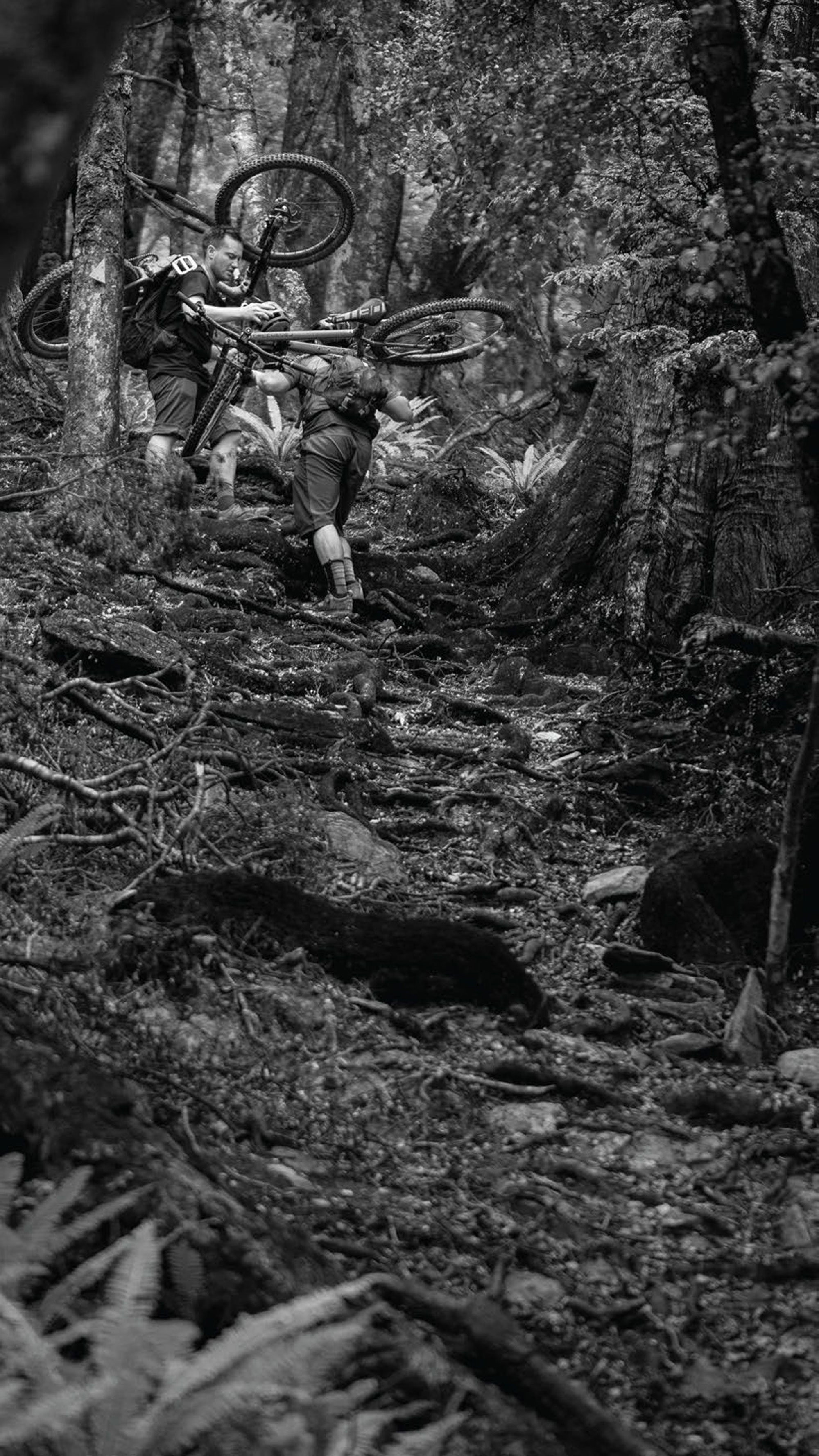
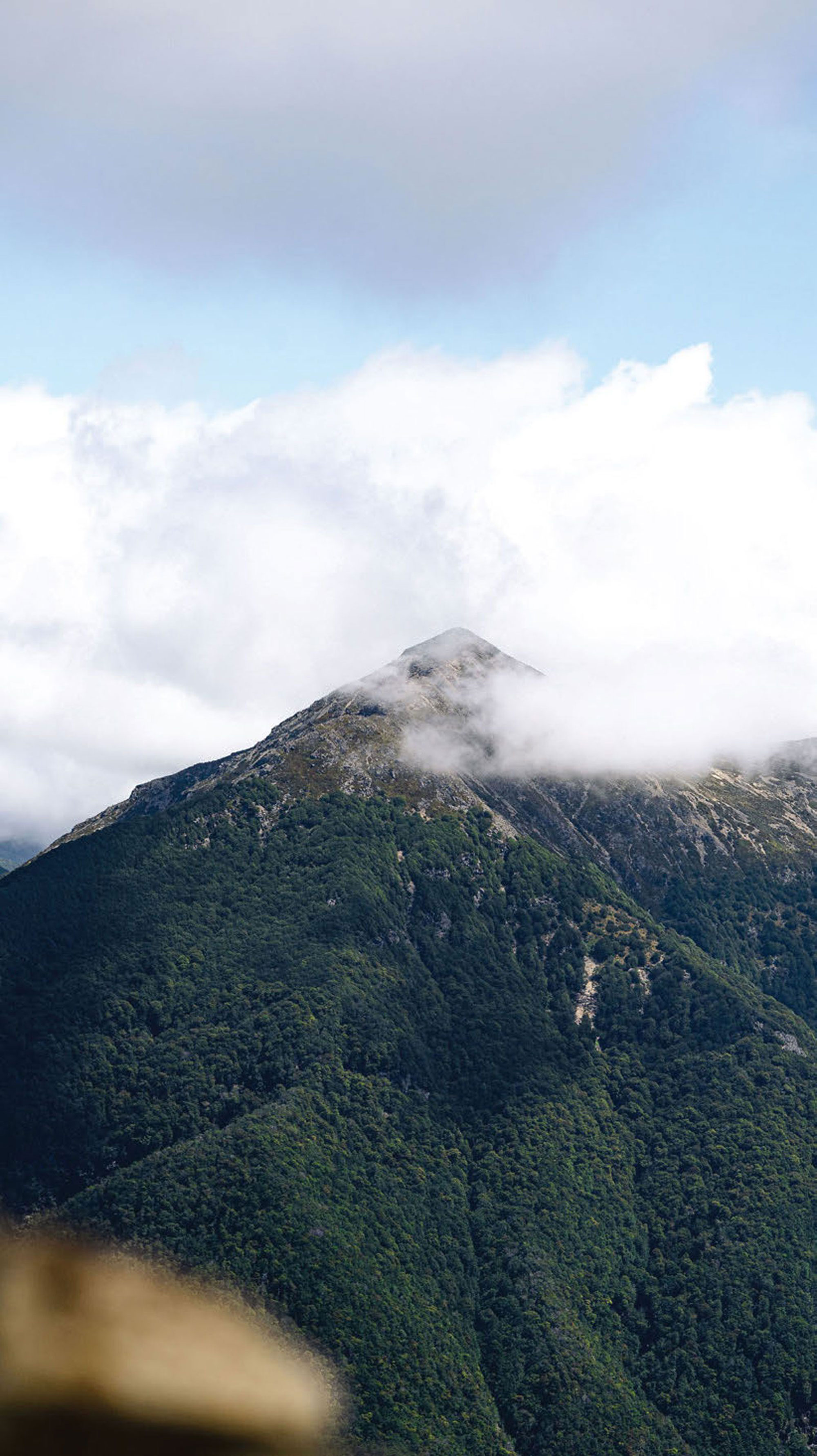
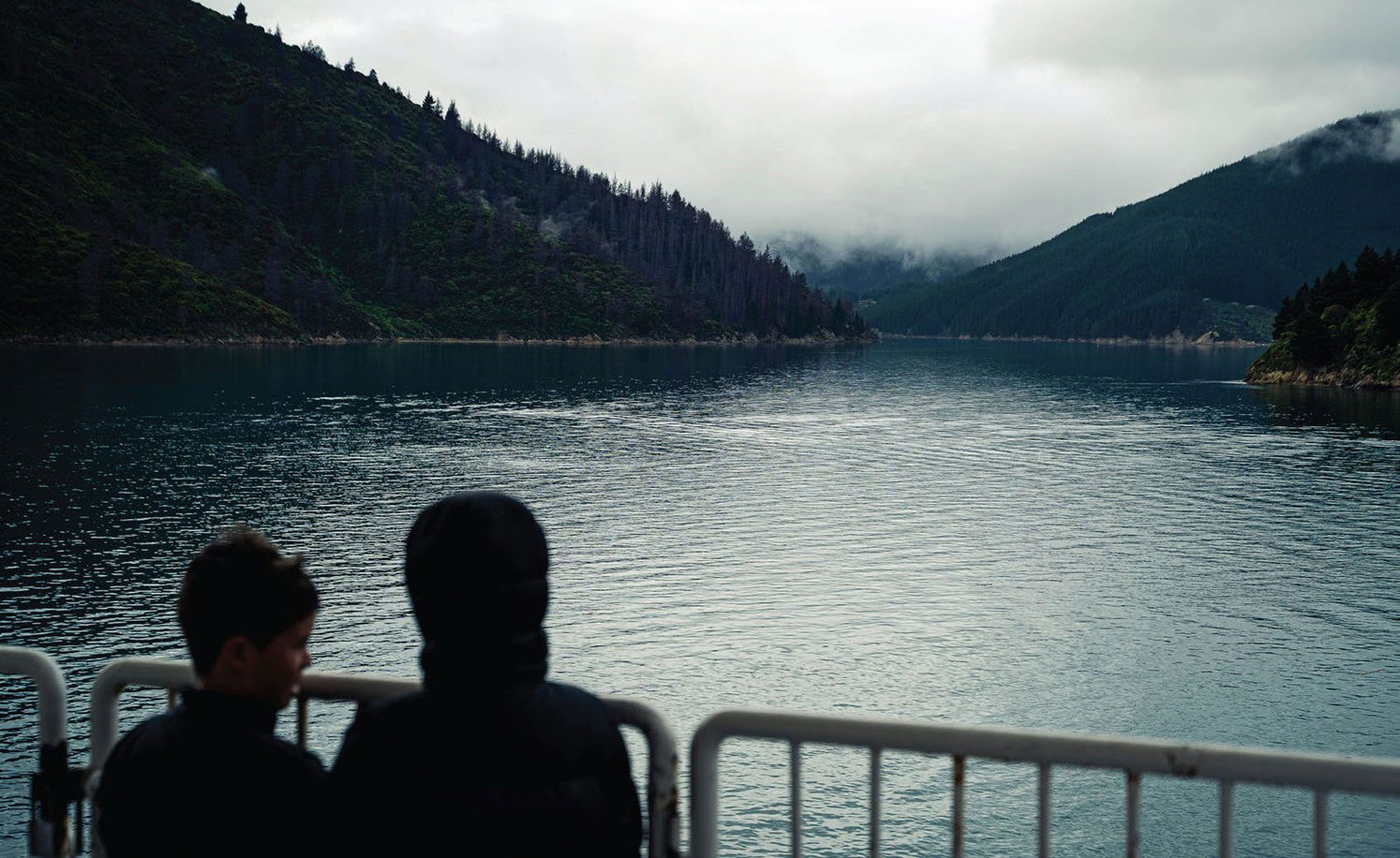
After a few more pints and an amazing dinner at the pub, the beer buzz of bad decisions kicked in, resulting in us getting a box to drink back at the hut that night. As it was starting to get dark, we hit the road back to the digs in good spirits. Back there, the box opened, and we continued into the night, with Bradshaw providing the entertainment again by unpacking and repacking everything as we watched him struggle. “What are you doing?!” we yelled, again.
The next morning, we were woken early to the sound of Bradshaw leaving. He was off early to ride to Nelson before a storm rolled in. The rest of us slept in a bit longer due to slight headaches from the beers. Today was going to be the easiest of the lot – we just had to get back to Picton before 6pm for the ferry back to Wellington. It was another overcast day with breaks of sun; not too hot, not too cold. Great weather to work our way back around Queen Charlotte Drive. My legs were feeling good this day for some reason; strong, powerful. I wished they had been like that over the last two days. It would have made life a lot easier. We stopped off in Havelock for breakfast and picked up some stuff for lunch. The pace was kept steady. We had all day to get to Picton. No big rush. It let us just enjoy the day and the ride. Really soak up the beauty of the place. We stopped at Ngakuta Bay for a swim in the sea, and lunch. The sun was out. The sea was the perfect temperature. Just tremendous.
The final 11km were stunning. One last climb before descending into Picton. I had Hybrid Minds playing in my earphones as we knocked off the last bit. The perfect soundtrack to the last bit of this adventure, speed tucking our way down the wavy road to Picton. The lush green canopy of trees and the views of the bays, mixed with the euphoria of completing this mission, made for a magical moment. What a time.
We stopped for a quick look at the viewpoint overlooking Picton before we rode down the road into town, grabbing the bag of clean clothes we had stashed two days earlier out of the bushes. We had done it. The Royale with Cheese ticked off. Another mission done, and it was yet another great one.
We had a couple of hours to kill before the ferry, so we got some second lunch, went for a swim in the sea again, then downed a few pints in one of the waterfront bars. We chatted about the mission we had just done; it wasn’t as hard as Ferry to Fishy, but it was a further distance. Breaking it into three days definitely made it a more pleasant experience. The ride around Queen Charlotte Drive was far nicer than the main highway to Fishtail. This time it seemed like the perfect amount of Type 2 fun (although you could argue that the more Type 2, the bigger the reward at the end). Royal was an absolute treat to ride, and getting to tick off some of the Wakamarina was a huge bonus. You couldn’t have asked for a better crew as well; just the best. We left the Capital on a Saturday morning, rode kilometres into the backcountry, rode a big mountain, rode back – and we were going to be back in the Capital by Monday evening. How good! Weekend adventures done right.
We boarded the ferry back to Wellington, found some good seats, and settled in. We hadn’t even made it out of the Sounds before we started talking about what was next. What’s going to be the next one we tick off? We have a few ideas in mind…. Watch this space.

SRAM GX Transmission
Words Lester Perry
Images Cameron Mackenzie
I’ve been aboard the SRAM GX Transmission for a few months now. During that time, I’ve been lucky enough to put this groupset to the test across a wide variety of conditions, on two very different bikes, and on everything from party laps with mates to full gas cross country racing.
My first experiences of the transmission were aboard my Trek Slash. A thoroughbred enduro rig, I’ve held this bike back from its true potential for a solid couple of years and it just keeps on giving. After a summer of just riding short-travel trail and XC bikes, I decided to solely ride the Slash over winter, no other bikes, so it got a good amount of use. I’d changed up a few things in my setup, including running vastly beefier tyres than usual, shorter cranks, and different suspension settings, and loved the changes. At the start of winter, the GX T-type groupset arrived and took the bike to a whole new level of awesome. In our previous issue, I discussed my initial thoughts after a couple of rides, mentioned a couple of minor issues, and was left with some questions about longevity and whether I’d still be so enthusiastic about the groupset after a few months.
A fair amount of literal and figurative water has passed under the bridge since I began riding the Transmission, and I’m confident to say that, for me, it’s a complete winner. But – it does take some getting used to. I sat back on one of my cable actuated geared bikes for a few laps of the street yesterday, just to be sure. Yep, I’m still confident it’s better in most cases.
The Triple Crown is the Rotorua MTB Club’s annual winter enduro; three stages on Rotorua’s finest grade 4+ trails. Rain had dampened the trails, but not to the point of total saturation; Rotorua’s volcanic soil effectively absorbing up most of the rain, leaving just enough puddles in the native bush to get a drive train nice and gritty. Aboard the GX mounted Slash, a quick few laps on the eve of the race to warm up, and over the three race stages during the following day – again highlighting the things I rate about the Transmission.
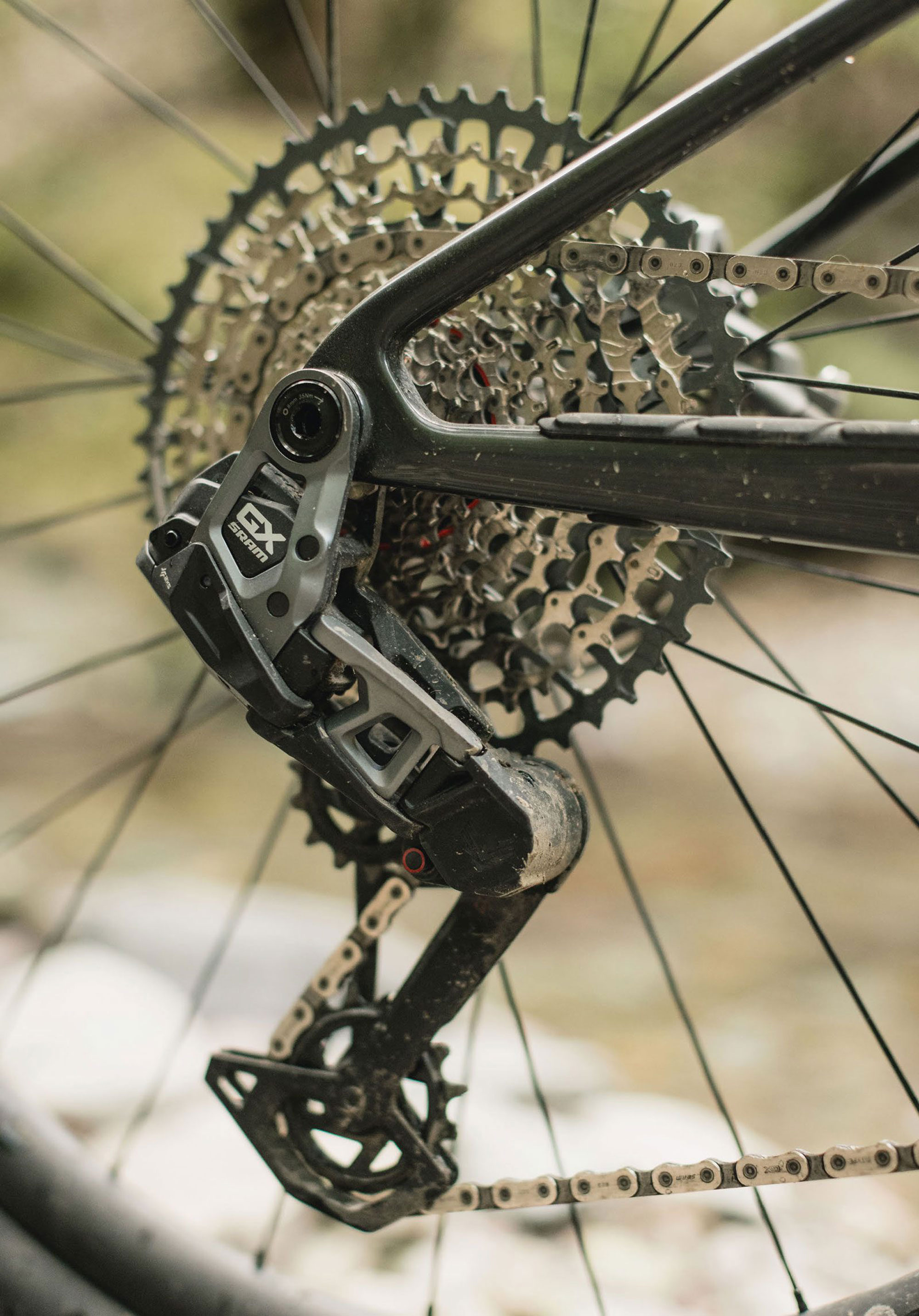
It’s quiet, the new clutch layout means less chain movement and a much quieter system – particularly when bombing fast, rough sections or hucks-to-flat; way less chain slapping the rear stays.
When racing Enduro, particularly on chunky rough or off-camber sections, you simply can’t get the pedals around everywhere you’d like to – so every pedal stroke counts. Short high-powered efforts, and lots of them; there’s no time for a wasted crank rotation to engage a partially derailed chain and, if you’re exiting a corner and need to be in a different gear, good luck with shifting a traditional setup under full power. The positive, solid feeling Transmission offers just can’t be beaten in this department. Go on, pedal full gas every time, all the time! I’ve been shifting more and throwing meaningful pedal strokes in where previously I simply wouldn’t have bothered or trusted my drive train under that level of aggression.
After my initial rides, I was concerned about smashing the low-hanging ‘Pod’ shifter off its perch – and I sure came close. At the Triple Crown, I managed to wash the front wheel on a root, sending me into a tree and a huge over-the-bars. Handlebars twisted and somewhat confused as to what had happened, I finished the run with a twisted cockpit, and when I went to shift gear into the finish of the trail there was no shifter to be seen. “That’s it, I knew this would happen at some point” was my first thought. Off the bike and about to walk up the track to hopefully retrieve the missing shifter, I realised it had just rotated around the bar and was now sticking out the front. Relief. With a quick twist of the mount, the shifter was back in its rightful place. I generally keep my cockpit controls loose enough on the bars to allow for impacts to rotate them, rather than break them off – and times like this highlight exactly why.
After the Triple Crown was done and dusted, I took delivery of another bike for review, again fitted with GX Transmission. This time, it was fitted to an XC rocket ship – the brand new Trek Supercaliber. With the Whangamata Black Rock XC race looming, I put some solid hours in aboard the bike and again gave the GX a good run.
Late winter conditions on my local Pirongia trails mean wet, muddy conditions and plenty of slop to keep things spicey. More than a few rides left the bike and drivetrain completely covered in mud. I’ve always been sceptical of electronics on bikes when it comes to using them in the wet and, although I haven’t completely immersed the system in water, it hasn’t skipped a beat when tackling numerous hours in very wet conditions -and the subsequent hose-assisted clean-ups. Even with a pretty decent amount of muck on the chain and derailleur, the transmission has performed equivalent to its performance in the dry, at times with a little more “crunch” in the chain than in the dry, but this is no surprise when dealing with a filthy chain.
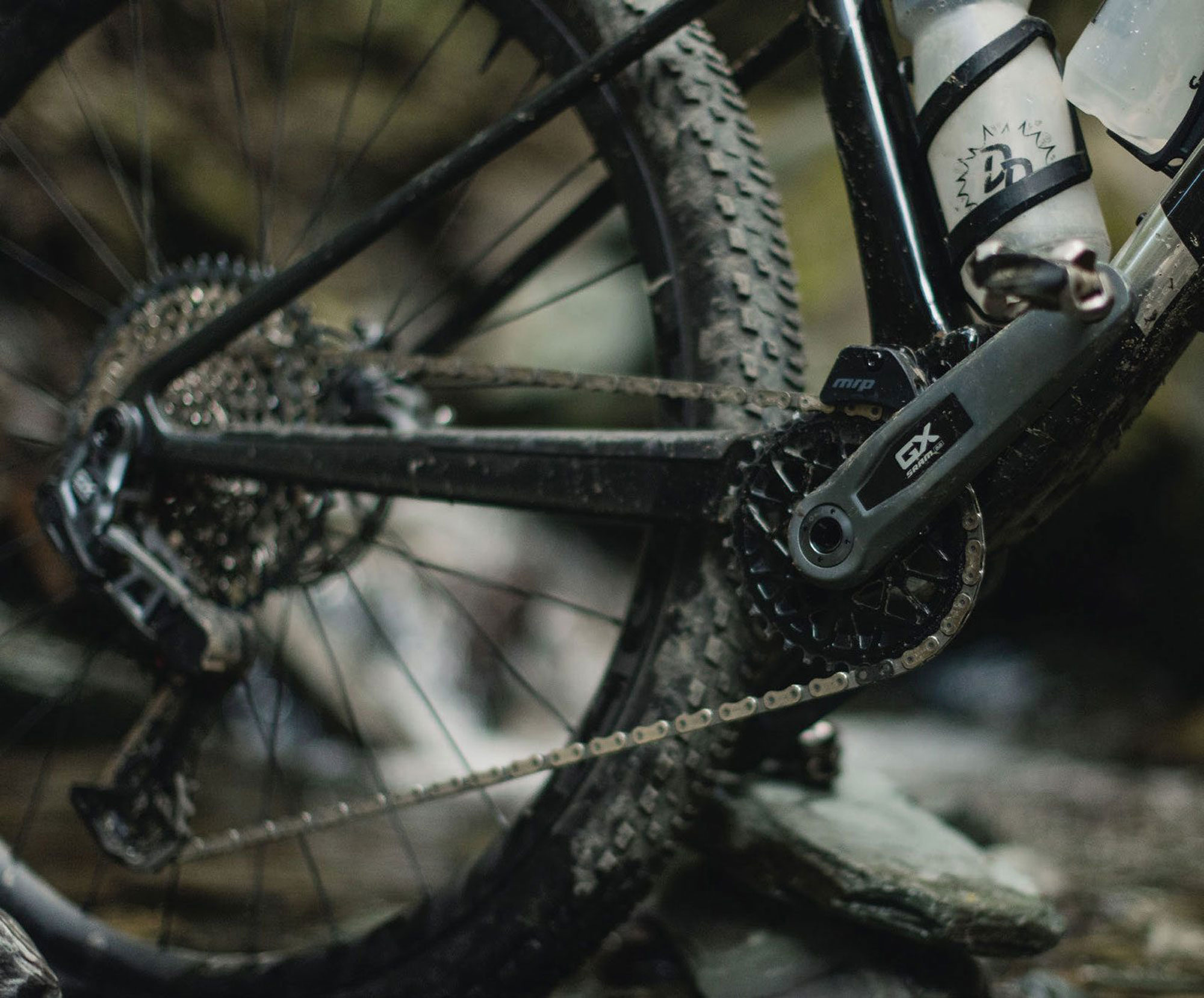
The positive shifting is welcome in the slop, and I found when either blowing a turn or sliding out, killing speed, the ability to just get on the gas and shift to the correct gear is so awesome. A simple push of the button and it’s there, no need for the ‘throw’ of a traditional lever.
Loading the car to head to Whangamata, I realised I’d never checked the charge level on the GX battery – cripes. Pushing the AXS button I got the dreaded red flash of sub 10% charge. Minor panic set in but I quickly clicked on that I had a USB port in the car, and simply charged the battery on my trip to Whangamata. Too easy.
Racing XC on the Transmission setup over the Black Rock 60-kilometre course was the perfect opportunity to throw a whole bunch of variables at the system. I again found myself shifting more often than on a regular cable- actuated system, and on reflection this let me spin at an optimal cadence more often.
There were a few sections on the course where snapping through gears while standing out of the saddle up steep pinches came in handy. Not needing to ease off the power helped get up the sections quicker and more controlled, without the need to ease off the power to shift and then go again. Consequently, rear wheel traction was more consistent and less likely to break loose; I simply wouldn’t change gears on some of these sections on a “normal” drive train and would have added unwanted fatigue to the legs needing to ‘grunt’ up them.
It wasn’t cold in Whangamata, but had it been a mid-winter epic in brutally cold conditions, I would have been stoked on the Pod shifter buttons over a mechanical style. My hands don’t deal well with the cold and I’ve had issues even changing gear on a cable system in the cold previously.
My time with the GX Transmission has by-and- large been pretty peachy but I’ve had one anomaly. While traversing a section of the Black Rock trace loop, just spinning along I pushed the button to shift up, and nothing happened; pushed up and down a few more times and still nothing. A flat Pod battery perhaps? Nope, those last for ages. Race brain took over and without any other smart ideas I gave the derailleur a firm bump with my heel as I rolled along, it made a couple of “zit zit” noises and everything went back to normal. I’m still unsure what happened, it hadn’t done this before, or since – so I’ll chalk this up to a total random event. It does remind me to read the manual for how to pair the system and reset it after an issue though.
My time on the Transmission is coming to a close for now, but hopefully not for too long. When SRAM’s marketing machine clogged every possible pixel of my online existence as they unleashed the T-type groupsets on the world, I really didn’t want to like it. But, truth be told, no longer do I view electronic shifting and SRAM’s GX T-type groupset as a luxury -more of a workhorse that’s enhanced my ride on multiple subtle levels. I’d gladly part with my own hard-earned cash to purchase a set to have for seasons to come.

Absolute Black Oval Chainring
Words Lester Perry
Image Cameron Mackenzie
RRP $199
Distributor FE Sports
There’s no denying it, an oval chainring is certainly a unique thing to see on a bike. But, why’s it an oval shape; surely the theories supporting their use died out with the old Shimano BioPace chainrings of the late 80’s? The fact is, Biopace rings weren’t true ovals, more squished rectangles with rounded corners.
Shimano’s Biopace and Absolute Black’s oval rings are both trying to achieve the same thing: to eliminate the dead spot in a pedal stroke, maximising the part of the pedal stroke where power is highest, and minimising resistance during the ‘dead’ part of the stroke.
Thanks to modern research techniques and measurement devices which weren’t around when Shimano’s Biopace was being developed, the final outcome in Absolute Black’s case is a chainring that is supposed to deliver smoother power and help a rider spin more effectively while climbing, all without Biopace’s associated knee pain.
Absolute Black claims a 9% increase in pedalling effectiveness, up to 7% less oxygen consumption, up to 15% decreased rate of breathing and up to 10% heart rate drop when using oval chainrings versus round. Some heady stats for sure.
First off, the quality of manufacture is as good as it gets, and there’s a fair bit of CNC wizardry that’s gone into bringing the chainring in at a minimal weight without appearing to have lost any strength (not something I was able to specifically test). The tooth profile meshes perfectly with the SRAM Flat Top chain and, so far, I haven’t had a dropped chain, or issues with the chain-to-chainring interface. There were no fitment issues when mounting the ring to the SRAM GX crank – everything was spot-on and precise. As far as longevity goes, after a number of rides across all trail conditions, I’ve got no reason to think the ring will wear any differently from any other chainring. I guess time will tell.
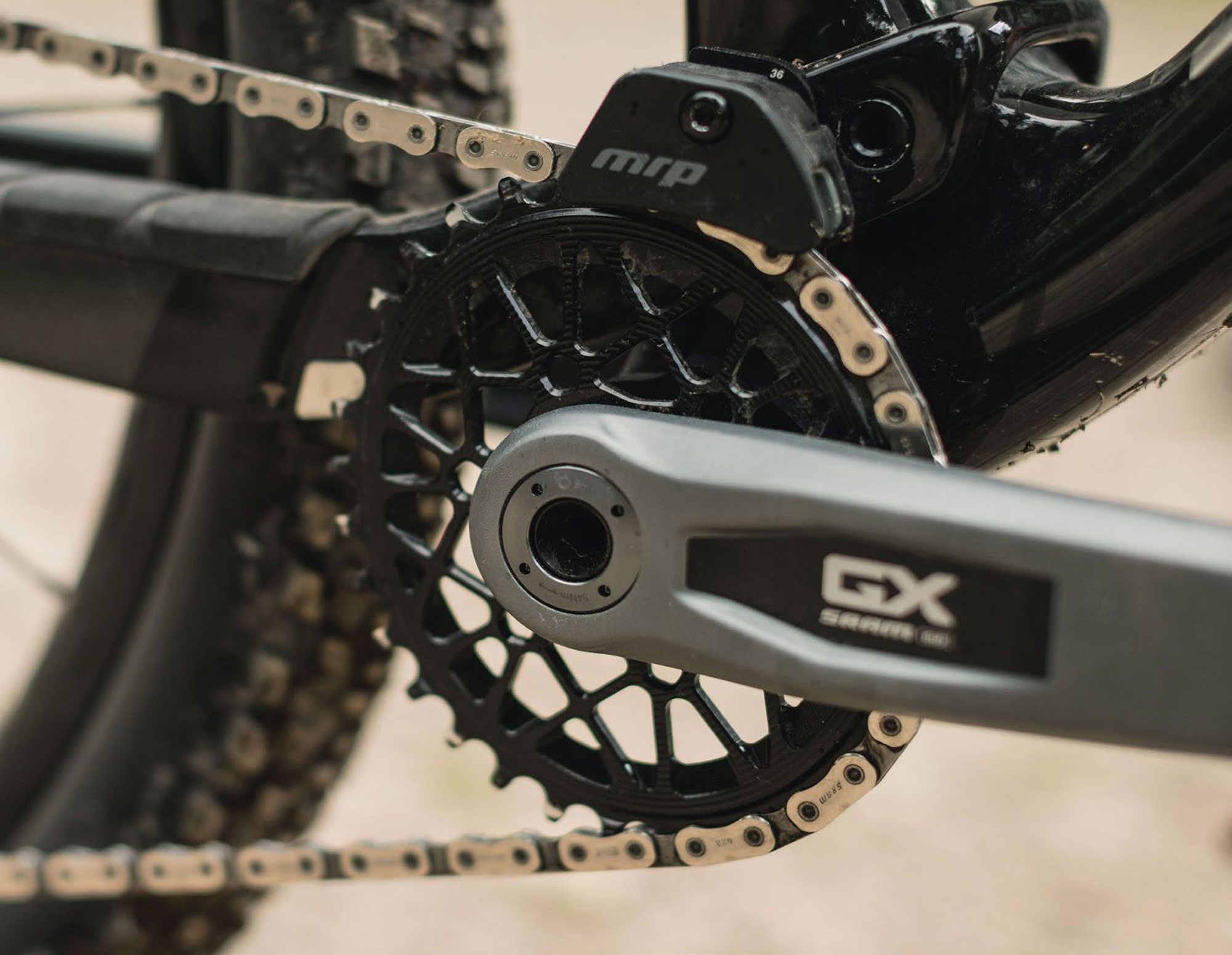
I tested the ‘do it all’ black version, although, if you’re after something to match the tone of your partner’s eyes (or your bike’s decals) you can also choose from titanium, gold or red.
So, how does an oval ring ride? The first few minutes on an oval ring are a bit weird, and probably enough to put some people off. There’s some sort of a feeling… like your cranks aren’t parallel, or they’re off-centre; it’s a strange feeling for sure. After around five to ten minutes, I find my pedal stroke adjusts to the new feeling and in effect cancels out the weirdness, leaving me with a smooth cadence that feels like I’m actually applying the same power throughout the whole pedal stroke rather than primarily on the down strokes. I haven’t done any hard timing but, anecdotally, I certainly feel like I climb more comfortably for the same power, and with less fatigue; it’s almost like I’m using all my leg muscles instead of just a few, effectively sharing the load (although that’s total bro science, not peer reviewed research by any means!).
It’s difficult to put a pin on exactly what the advantages are in the real world, although one noticeable trait is that it smooths the power delivery, meaning more consistent power at the wheel and fewer traction issues whilst climbing on the loose. In turn, this appears to keep your heart rate lower, or at least more stable, than if you were having to adjust your input to the pedals to stop from breaking traction.
The chainring I’ve been reviewing has been strictly on an XC bike while under review, but, I’ve used an oval ring on my “big bike” – a 160mm travel Enduro sled – too. Initially, I thought an oval ring may not suit a bike which is often being sprinted out of the saddle. My theory was that the oval would feel bizarre or lumpy in this situation – I was wrong. The oval didn’t seem to feel any different while standing and attacking out of the saddle, however, it did make climbing to the top of the hills just a touch more comfortable.
It’s not all beer and Skittles though; depending on what size oval ring you run, and where the top of the ring sits relative to your main suspension pivot, an oval ring can actually accentuate pedal-induced suspension bob, interfering with the bikes anti- squat between the ‘high point’ and the ‘low point’ of the chainring as it rotates. I’ve only found this noticeable on one bike, but it certainly confirms that this is a real thing. It wasn’t a major issue, but if every watt counts (i.e. on an XC bike) it’s worth considering what impact this may have on your specific bike. It’s XC riders who stand to gain the most from using an oval ring, so it’s worth weighing up the possible pros and cons. If I was riding a hard-tail it would be a no-brainer to run an oval.
What it all boils down to: if you want to climb more comfortably with better efficiency, and maintain traction more easily while climbing, all of which may ultimately make you faster and save some energy, then certainly consider an Absolute Black oval ring.

Camelbak Podium 4 Hydration Belt
Words Lester Perry
Image Cameron Mackenzie
RRP $109
Distributor Southern Approach
Imagine, if you will, purchasing a nice new bum bag, fresh off the bike shop wall. You pay the assistant, fit the waist strap in place and waltz out the door with that ‘new bum-bag’ spring in your step. Strangers look sideways at you, the child walking toward you is ushered across the road by its mother. It’s then you realise you’re in a mountain biker version of the old “togs, togs, togs; undies” Tip Top advert, except the undies are, in this case, a bum bag.
Generally not so accepted in normal life, but very common when on a MTB or while sifting around a trailhead. As budgie smugglers would be frowned upon while strutting down the street, equally a bum bag may raise eyebrows.
Not since the mid-1980’s have we seen the prevalence of bum bags that we’re seeing in MTB parks currently. The bum bag moniker is gone, replaced by a more ‘PC’ name: the ‘hip-pack’. They come in all shapes and sizes; some include hydration bladders, others don’t; some have heaps of storage, and others are simpler, slim line and more minimal.
With the prevalence of eMTBs and long travel trail bikes, and their many frame configurations, we’re finding bikes have lost much of their ability to haul enough liquid for a big day in the saddle. Gone are the days of the classic front triangle able to fit two 900ml bottles. Many bikes now will only fit a single 500-600ml bottle or, in some cases, none at all. A full hydration pack is a solid solution, but these come with their drawbacks, and will likely be overkill for most rides. If you’re restricted to either a single bottle or, heaven forbid, none at all, then the hip pack hits that sweet spot between a single bottle hour-long ride, and a half-day epic with the need for a larger, full-blown hydration pack.
The CamelBak Podium Flow 4 Hydration Belt is in the middle of the range when it comes to storage capacity, with four litres on offer. The supplied 600ml Podium bottle fits comfortably in the centre of the pack. To either side, two zippered pockets with internal dividers keep the contents separate and secure. The fabric of each outer pocket is elasticated to effectively compress the load closer to the body and help stop the cargo from bouncing around too much. Throughout its four pockets, there’s enough storage for all your ride essentials, plus a phone and snacks – but not a great deal more; just the necessities. Along the base of the pack, are some loops intended to hold a pump – I’m not sure what sort of pump they used to model these off as I couldn’t get it to work adequately with my pretty standard mini pump.
Loaded up for a ride, the Podium Flow 4 Hydration Belt fits snugly around my waist. I fit it as low across my hips as is practical, to avoid it interfering with my breathing. The buckle closure is low profile and easily adjustable to fit a wide range of waists. Excess straps are kept from flapping around by elastic loops on the waistband, although these could easily be trimmed to suit the wearer. With room for everything in one place, I don’t need to trim the number of any of my tools or spares to be ready for every eventuality -just grab the pack and go.
One thing I rate about running a hip-pack, is how free and airy you feel compared to when wearing a full hydration pack. On a roasting hot day, a full pack limits your body’s cooling ability, a situation where a hip-pack wins out for sure. To maximise breathability next to the body, CamelBak has incorporated their ‘Air Support’ back panel -essentially a panel of open foam that spaces the pack off your back somewhat to help with airflow between the two. I’m a big fan of CamelBak’s Podium bottles, they’ve refined the design over the years and now that the nozzle is easily disassembled for cleaning, they last for years. The ‘dirt’ series bottle included, has the added touch of a rubber cap covering the nozzle – no more trying to blow dirt from the mouth before taking a swig. I like it! With the bottle sitting centrally on the Hydration Belt, it’s simple to reach from either side, although it’s not the easiest to do while riding. Maybe I’m a bit cack-handed, but I find I need to stop moving to reach it comfortably. Fortunately, my bike fits a bottle so, on occasion, I’m not carting a bottle in the hip-pack, instead stuffing a jacket in the bottle holster.
Even while loaded up, I find the Hydration Belt sits nicely on my hips, although, over a long ride there’s a slight creep in the belt and it needs to be retightened to stop it from moving around too much. Riding in a normal, semi-upright position, on a trail or enduro bike, the fact I’m wearing the Hydration Belt barely registers but, in a more cross-country style position – long and low in the front -if I’m breathing heavily, I do find it cuts into my midriff a bit; hampering breathing somewhat, even when worn low on the hips.
If you want to keep all your riding necessities safely in one spot and not be limited to what you can stuff in your pockets, or maybe just need to add to your hydration capacity, then CamelBak’s Podium Flow 4 Hydration Belt is a great addition to your riding kit.

Bell Sanction 2 DLX
Words Lester Perry
Images Savanna Guet
RRP $329
Distributor Worralls
Thumb your way back through the pages of a mid-1950s Hot Rod or car racing magazine and you’ll see Bell’s distinct graphics adorning helmets worn by some of the scene’s most influential drivers.
Years later, during my formative years – back when 4-cross and Downhill were making waves in the early-mid ‘90s – posters plastering my bedroom walls featured riders wearing Bell: Brian Lopes, Cedric Gracia, and even some vintage John Tomac. To this day, their helmets protect some of MTB’s heaviest hitters (heaviest in style and speed, not weight!).
Born out of the desire to create a safer helmet for race car drivers, founder Roy Richter worked with naval pilot, Frank Heacox, taking learnings and technology from other industries and reverse-engineering existing helmets. In 1954, the Bell 500 launched, featuring a Polyurethane Foam liner with a hand-laid fibreglass shell. Bell still draws on this motorsport heritage, incorporating many ties back to the 50’s Hot Rod culture across its modern range.
The original Sanction full-face piqued my interest for all the wrong reasons. I won’t mince words – in my opinion, it was pretty ugly. It’s a real bummer when consumers are put off buying protective equipment because of looks, particularly when it’s a price-point-oriented piece; why can’t cheap stuff also look good?
Fortunately, the newly released Sanction 2 DLX MIPS is a complete redo. Taking design cues from the Full-10, Bell’s heavier-hitting top-of-the-line model, as well as others in the Bell line-up, the refreshed model bears no resemblance to the original. This new lid is aimed squarely at the more value-conscious consumer and, although it hasn’t got all the fancy bells and whistles of its pricier and more tech-heavy cousin, it packs plenty of comparable features into its smaller price tag.
Sliding into the helmet for the first time, I was instantly transported back to being a kid and putting on my dad’s motorbike helmet (he had a helmet, but I don’t recall a motorbike?), the plush padding damped the surrounding sounds and I was transformed from a Regular Old Joe to a Power Ranger of sorts, ready to take on whatever challenges -or trail -lay ahead. I have no complaints about the feel on my head; it fits like a glove. The padding incorporates embedded silver metalised yarn for odour control and antimicrobial properties, helping to keep it stink-free. Cheek pads are easily removed for washing, again helping to ward off the mid-summer stank. Generous padding throughout the helmet makes for superior comfort but likely hampers airflow. On a hot summer’s day, it could get pretty warm, although, with 14 airy vents, it’s likely to only be an issue while at slow speed or standing around waiting for the next uplift. I’m a big fan of the Fidlock magnetic closure. I’ve got no idea how it actually works, but it seems to be a blend of magnets and voodoo magic, with no need for “eye of newt” or a Magic Wand. If you’re dialled, you’ll be able to snap the buckle closed single-handedly, and even the most cack-handed users can pop it open with a flick of thumb and forefinger.
Rotational forces are taken care of by the OG MIPS Essential liner. For the uninitiated, this is a proven technology that uses a ‘slip plane’ to help reduce head and neck trauma during an impact. The DLX model weighs a claimed 1080 grams in the medium size, lighter than some higher-end and more spendy offerings in the market. Riding the helmet is everything it should be; it’s comfortable and doesn’t feel unwieldy. When riding at speed over chunky terrain there’s a small amount of movement in the MIPS system so the helmet can at times move around a small amount. This is a common thing with the MIPS Essential system, but not something that detracts from its use, however, it’s not so evident in the more premium MIPS offerings featured in higher-end helmets.
Googles sit well on the helmet and there’s no interference between the helmet and the goggles themselves. The goggle strap sits tidily in a shaped channel around the back of the helmet. If you want to slide goggles up to your forehead while not in use, the visor moves up, out of the way just enough. Fortunately, I haven’t needed to test Bell’s safety claims but with all the necessary safety standards met, I’ve got complete faith that, should I take a spill, the helmet will do what it should and protect my swede.
A solid mix of styling, protection, and price makes this a worthwhile purchase for anyone in search of a decent full-face helmet, particularly if you see a full-face helmet as a nice-to-have, not a must-have, or maybe you only need one every now and then. Steer clear of the spendier options and save your money for some extra uplifts! A wide range of sizes are available, so if you’re in search of a full-face for a BMX or gravity mad grommet, then this would be a great option.

Abus Cliffhanger MIPS Helmet
Words Lester Perry
Image Cameron Mackenzie
RRP $350
Distributor Southern Approach
Creating a helmet sure is a break from tradition for a company that has always designed and manufactured security solutions. Beginning with padlocks in 1924, and moving on to high-tech security and smart home solutions, these days Abus bike locks are some of the finest around – you’ll even find their locks securing many eBike batteries into their frames.
Beginning their helmet design journey with road helmets, protecting some of the pro peloton’s fastest racers, we’ve recently seen their range expand to offer a wide variety of MTB models. The range has been designed in conjunction with feedback from freeride legend, Richie Schley, and downhill fast-and-funny guy turned commentator, Cedric Gracia. Abus’s Cliffhanger MIPS takes no shortcuts. It leads their trail helmet range with its tech, and style that leans more towards Enduro or gravity riding than light trail or XC. The Cliffhanger incorporates familiar tech you’ll find across many other high-end helmets.
The Cliffhanger’s in-mould shell brings together the outer shell and the inner shock-absorbing foam (EPS) and bonds them as a single piece. The shell has eight air inlets and six exhaust ports which, when coupled with the effective internal channelling, gives the wearer a substantial amount of venting even on the hottest days. Cool air in, warm air out – simple.
Take a saw to the shell and you’ll find the ‘ActiCage’. This is an internal structural reinforcement which not only helps distribute impact force and hold the whole helmet together during successive impacts, but offers additional reinforcement allowing for the use of ample-sized front vents. All edges on the shell are encapsulated by the in-moulded outer shell, adding to the durability of the whole package.
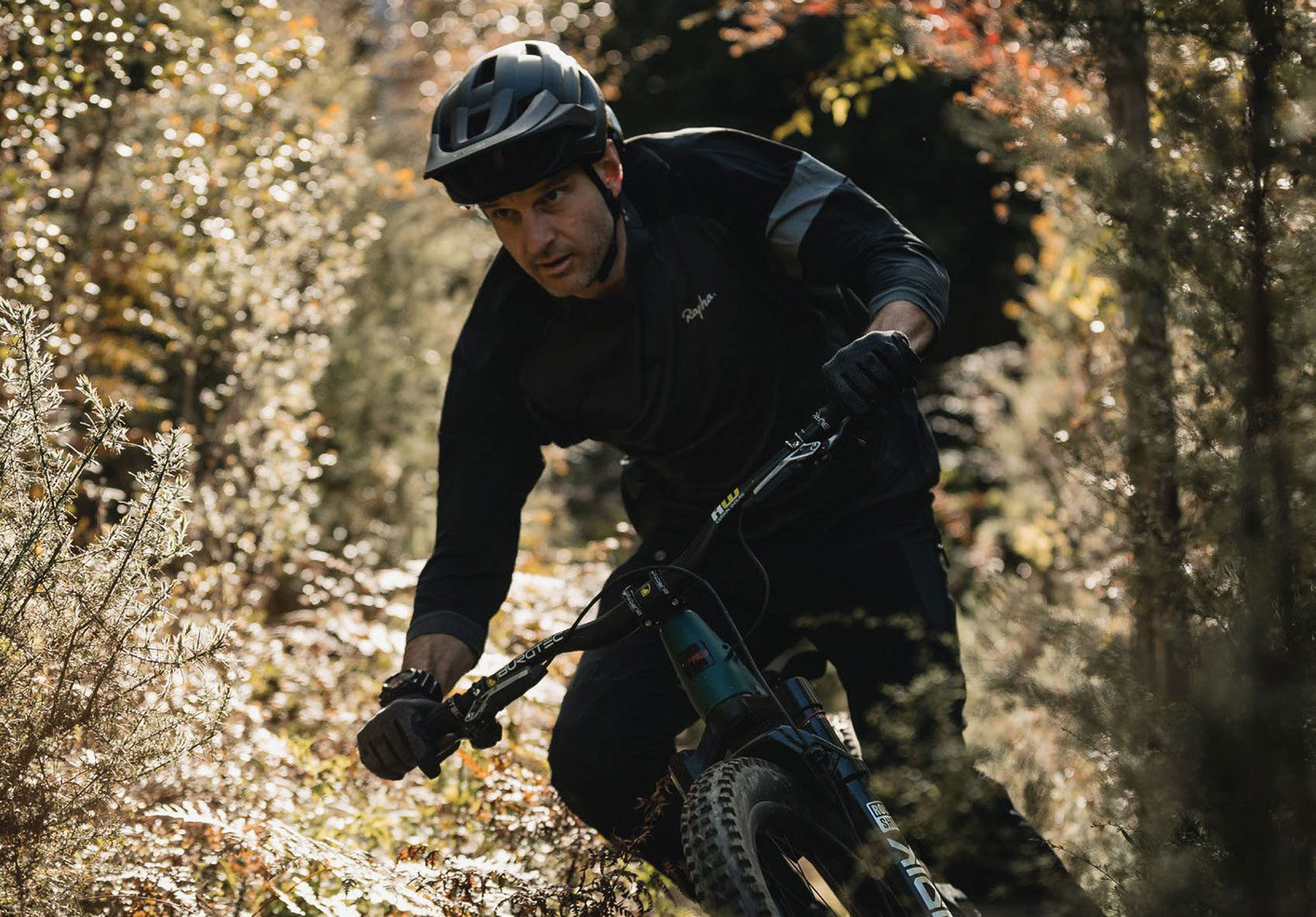
Out front, as with any helmet designed to be worn with baggy shorts, you’ll find the peak (not that there are rules, but IYKYK). In the lowest of the three vertically ‘notched’ adjustments, the peak’s lines flow almost seamlessly onto the main helmet but, once you raise it through the other settings, the lines aren’t quite as smooth. However, it still does its job just fine. In the highest position, there’s plenty of room to house your goggles during a climb if you’re so inclined. I’ve found the middle position suits me best as, when it’s in the lower setting, there’s just a touch too much of the peak visible at the top of my view – maybe that’s just me, though. If it were a couple of degrees higher, without having to go the next click up, it would be spot on, and that second click up just disrupts those smooth lines I mentioned. I’ve seen peaks that snap onto a shell in a similar way to this, which have seemed quite flimsy and wear out after being taken on and off a few times; the Cliffhanger’s snap-on system is well designed and of a quality that appears it will easily last as long as the rest of the helmet, so no need for concern there.
The meat in the three-layer sandwich between helmet padding and EPS foam, is a pared-back MIPS liner. It appears the designers have trimmed the liner, removing any excess or areas which may disrupt airflow. The padding is minimal but comfortable. It feels soft to the skin and wicks sweat well; there’s not much padding at all but, overall, the helmet feels perfectly comfortable. I put a lot of this down to a well-designed helmet shape. The minimalist padding may potentially mean the lid doesn’t fit some as well as others, although with tight 4cm size ranges this may be alleviated. Our test helmet is a Medium at 54-58cm; Small measures 51-55cm; and Large comes in at 57- 61cm – so a decent sizing spread is available.
I’m impressed by the weight of this helmet. It felt light on the head, and I confirmed this by weighing it on a digital scale. It measured in at just 352 grams – at the lighter end of the scale when compared with similar helmets of comparable coverage and equivalent features.
A Fidlock closure takes care of the chin strap and holds the whole helmet comfortably in place. Abus’s TriVider strap system gives a level of lateral adjustability and sits nice and flat next to the skin – a lot lower profile than some of the competition. Out the back, there’s a Boa-esque dial to easily adjust and get the fit just right. The cradle has ample vertical adjustment to help avoid any lumps and bumps, and there’s a nice gap through the centre to let a ponytail flow free, unhampered. The overall silhouette provides ample coverage all around; the deep drop in the back of the helmet hooks forward, hugging comparatively close to the ears and offering loads of protection.
There’s a lot of subtle tech packed into this lid and its looks appear to draw inspiration from several other high-end helmets. It could be said that Abus have taken the best of a whole bunch of helmets and carefully combined elements of each to come up with a really solid competitor in the trail helmet category.
I’ve been loving the Cliffhanger. It’s comfortable, airy, hyper-adjustable, feels secure and solid on the head, and has unique yet strangely familiar looks. I’ve had a hard time trying to pinpoint something I don’t like with this helmet and, while it’s drawing a long bow, all I can find is that, for me, the three adjustments in the peak height just aren’t quite right. I’ve gotten used to it now, but if I had my way they’d all sit a few degrees higher than stock, meaning the peak is never in view… but maybe I’m just picky.

Shimano GF600 Shoes
Words Lester Perry
Image Cameron Mackenzie
RRP $249
Distributor Shimano NZ
Heading out on my local trails over recent years, I’ve noticed a resurgence of people riding with flat pedals and shoes. There’s still plenty of riders choosing to clip-in, but it feels like these people are fewer than before. Some of this has been the change of mountain biking demographics as the number of people just out for a good time, not a fast time, has increased – in part due to the Covid lockdowns and associated ‘bike-boom’.
With an increase in people looking for the comfort and convenience of flat pedals, so too the number of shoe and pedal options on the market has increased. Shimano recently revamped their MTB shoes line and, although it seems like they do this every couple of years, they continually knock it out of the park and have top-shelf, but generally subtly styled, options available – regardless of your riding genre.
It’s not just sticky rubber that makes a quality flat- pedal shoe. A well-thought-out flat-pedal shoe is a sum of all its parts, and if any part is lacking they’ll be heading for the trash heap to join the other 22 billion shoes globally that end up in landfill. I’ve been spending time back on flat pedals after years on clips, and it’s been refreshing to ride flats again – no doubt helped by the new Shimano GF 6 shoes. So far, they’re affirming the “buy once, buy right” adage and it appears they’ll last longer than other flat shoes I’ve seen in the market recently.
The GF6 upper is constructed from hardwearing synthetic ‘leather’. Some texture and reinforcement are added around the front of the shoe for increased toe protection and some styling. The toe box area has a matrix of holes punched in it to help with breathability, and more holes further toward the back of the shoe also help with this. The upper is relatively slim-line – gone are the days of overly-padded heel cups and shoe tongues – replaced by lower profile, but equally (possibly more) comfortable foams. Less padding and the use of modern foam means that in wet conditions the shoe doesn’t become a sponge and get weighed down once sodden. A slightly higher cuff to the ‘inside’ of the shoe offers some additional protection to ankle bones. Following the slim-line trend, the tongue isn’t bulky and sits nicely in place once laced up. Two subtle features on the tongue are worth noting: an elastic loop with a small pull tab for lace storage, stopping laces from snagging on trail debris or coming undone while riding; and the label on the ‘top’ of the tongue is slightly rubberised, offering a bit more grip to grimy hands while pulling the shoes on. These are both minor details that could easily go unnoticed, but these little touches are proof of Shimano’s experience when it comes to developing shoes.
Shimano has utilised a new fit for the GF6: the ‘Volume Trail Last’ gives ample room at the toes for comfortable walking, while from the ball of the foot back the fit becomes slimmer and more precise, ensuring maximum power transfer and bike control. I am regularly a size 9 US in most sneaker brands, but I find Shimano MTB shoes fit a fraction larger than an equivalent Nike sneaker. My feet aren’t ‘Frodo Baggins’ wide, but they sure aren’t ‘Euro-pro XC racer’ slim either – they’re somewhere between the two; pretty regular-shaped Kiwi bloke feet I think (although I don’t go around checking out other people’s feet!). With this in mind, the fit of these shoes is pretty spot on for my hooves; they’re not quite as comfortable as regular sneakers but you forgo some of the sneaker plushness while walking in favour of pedalling comfort and efficiency. The roomy toe box is certainly noticeable -and a welcome change from the clip shoes I’m accustomed to.
Shimano brings yet another rubber compound to the category with the ‘Ultread GF’ sole – which claims to be optimised for gravity riding. I’m unsure why you’d want a different rubber compound for regular, non-gravity riding, but it seems Shimano think you do. I’d imagine the best rubber for gravity-assisted riding would also be the best rubber for less demanding trail rides or eBiking. Whatever the case, the rubber they’ve used on the ‘Ultread GF’ sole is plenty grippy, seemingly a combination of the raised hexagons that form the tread, and the soft, slow rebounding rubber. Why a slow rebounding rubber? Slower rubber doesn’t try to push the pedal pins away, helping to keep it in place until you take the weight off the pedal, a huge factor in how grippy a flat shoe is. There’s ample grip on offer with the GF6’s; I never once slipped a pedal and even during some sketchy moments, the shoes were surprisingly well “locked on” to the pedals. There’s a tricky tread design on the toe and heel areas of the sole that adds some extra bite while walking.
It’s worth noting that a good flat-pedal shoe is only as good as the pedal you’re using them with. Throughout the test period, I used them with a popular ‘large’ sized pedal featuring a slight concave and 10 regular-length pins per side. The downside of so much grip was the complete inability to adjust my feet on the pedals, while even just slightly weighted – I needed to lift a foot to then adjust where it sat on the pedal. This was a slight niggle that’s just a drawback of such an effective interface between pedal and shoe… but if it’s grip you want, then it’s grip you get!
The midsole has a very skate-esque appearance, and the EVA rubber offers some comfort while walking – not heaps, but enough. What it does do, though, is provide a good level of comfort when on the pedal. The midsole also features the ‘Torbal 2’ torsion plate which, according to Shimano, offers increased flexibility on the edges of the shoe, adding control during gnarly descents. In the real world, I can’t really feel the subtleties of what they’re on about, but there’s certainly a welcomed level of stiffness to the sole while pedalling but it still retains a comfortable amount of torsional flex which I’d imagine does help pedal traction whether you’re swinging off the back while tracking over the chunder, or making shapes while shralping turns.
What’s the verdict then? If you can look past all the marketing hype, acronyms and brand names for every shoe feature and simply take into account the comfort and overall level of grip on offer, I’d have a hard time suggesting that anyone would need anything different from the GF6. There are no weak points on the shoe. If they fit your feet properly and you like the subdued style, there’s no need to look elsewhere.

Because I Can
Words & Images Gary Sullivan
Last weekend, for the first time in years, I hung a number on the front of a bike to go racing.
Spotting the difference between me racing and me just aimlessly riding around in the woods is not easy. Averaged out over any decent amount of distance, the pace is about the same. Keen observers on the day would note the conga line of other riders, some yelling “on your right”. I was somewhere in that mess, and therefore, “racing”.
The team at the shop I associate with got excited about the project, and offered me a loaner for the big day: a svelte race machine a bit lighter and leaner looking than my personal deluxe trail sled. I took it for a midweek spin to figure it out and, while it felt very fast, how fast something feels is very subjective. Against my historic efforts along the same trails, it was pretty good. The historic efforts that were faster were a while back, and so the ravages of time need to be taken into account. And I decided, if it feels faster, maybe that is enough. Every little bit would help me achieve my goal, which was to finish.
The event I entered was the Whaka50, which is the sweet spot event in the Whaka100 weekend. I know from bitter experience that the Whaka100 needs to be taken extremely seriously, and the 100 Mile version – with a start in the dark and over 4000 metres of climbing – is beyond my comprehension or scope in this lifetime.
Neither too short nor too long, the 50 can be attacked without much preparation. If you are moderately skilled at mountain biking, it is achievable. If you don’t go too hard, you can finish it in reasonable shape and even enjoy some of the experience.
Probably because of these things, it attracts the biggest field; sold out at 1200 riders. It gets a day of its own, sandwiched between the eliminator battles on the Friday night and the big kahunas on Sunday. This makes the incredibly well-executed logistics of the whole thing more manageable.
As far as management goes, the Whaka100 weekend is the gold standard for events, in my opinion. Tim and Belinda Farmer and their team do an incredible job. Everything has been thought about, a lot. The race village is a work of art. The course marking is very complicated, wringing 160 kilometres out of a spaghetti bowl of trails takes some major mental gymnastics. It is completely nailed down. The 50 is mercifully simple, as a local I was familiar with every trail.
Here is how it went for me in the middle of the pack:
First of all, the day was spectacular. Dry, high cloud; warm without being super-hot.
Coffee/breakfast executed without issues.
Arrive at venue; meet fellow competitors, banter.
Short warm-up.
My spot in the start chute was far enough back from the start line itself that we had that weird delay between the sound of the start signal and actually moving. And, even once we got underway, there was serious traffic. Into singletrack; fairly flat, very tight, and more or less one lane. There were very few places to pass, and little point in doing so. Admirable patience was displayed by nearly everybody. Only a couple of deranged, over-caffeinated units attempted it, and didn’t really progress much. The one-lane queue situation continued for the first quarter of the race, but that was actually a good thing. It meant I couldn’t follow my natural instinct to go like a mad rabbit until the lights go out, usually long before halfway. Like everybody else, I went as fast as the rider in front of me.
When things finally opened up, the field had strung out enough that for the rest of the ride there was plenty of room. I got lucky enough to have a clear run on all the sections I was looking forward to (the downhill bits) and only a few people for company on the bits I was not so keen about (the uphill bits).
Sometimes, in events like this, a duel is generated by chance. That is one of the very good things about mountain bike races. No matter where you are in the proceedings, there will be somebody else to try to beat. For us (a guy in a blue Lycra outfit and me) the thing lasted almost the entire race.
He was much better than me at going uphill, I was a bit more useful at going downhill. Between us, our advantages averaged out. Two photos taken 35 kilometres apart show us together, and yet, for most of the event we were not even in sight of each other. He got past me for the final time near the end, and whatever gas I had left in the tank was not enough to do anything about it.
A few hours in, I questioned what I was doing, and why. The event was in my local patch, and I am lucky enough to be able to ride the same trails any day of the week, free of charge.
These questions were repeated, often, once we got to the pointy bit of the course. The long climb to the top of Lobotomy, for example. On the constant pinch climbs of Old Chevy. And, after the indignity of the pond. The course is completed by the crossing of a little pond, which can be done neatly and almost bone dry if you hit the little ramp just right and clear the thing. A crowd gathers to watch, and riders can hear them yelling and laughing for quite some time before arriving on the scene.
A sharp left turn off a small ridge drops riders down a steep chute to the crossing. I should have had a look at the run-in to the ramp before the event, my habitual exit to that particular trail avoids the pond altogether.
I didn’t, so my attempt to jump the pond fell short by a metre.
The struggle out of the muddy slot created by hundreds of people doing their own versions of my stunt is an ignominious end to an otherwise great day.
Cursing my stupidity in even entering such a ridiculous race only lasted a few seconds. Then I was on the grass, between the banners, and arriving at the finish line in one piece.
The next few minutes is a bit of a blur but, soon enough, I was in a patch of shade, laughing with some mates and feeling really good about the enterprise.
At that point, I could clear my head and figure out why I signed up for the race -and realised that probably the main reason for doing the thing was, simply, because I can. No matter where you are in the proceedings, there will be somebody else to try to beat.

Plastic Memories
Words & Images Lester Perry
Recently, I was fortunate enough to get my own space in our house. It’s an office, gym, bike and gear storage room, and a place to keep many years’ worth of bike-related things. Some may call it a man cave, others may call it a mess – whatever it is, it’s mine and it’s just how I like it.
This new space came with fresh, blank, unadulterated walls; the perfect spot to add some character and colour. Moving boxes from the shed to the new room gave me the opportunity to crack open a bit of a time capsule of sorts, a cardboard box that’s previously sat in the corner of my garage gathering dust and spider webs. Within this box was a treasure trove of memories in the form of event number plates, over 100 of them, dating back as early as 2009. This is by no means a complete set of all the events I’ve attended in my time, but offers a good cross-section of places ridden, and time spent riding with other like-minded bike nutters.
One dreary Sunday afternoon, banished to the four walls of my new space with monsoon-like conditions outdoors, I sat with a fresh packet of Blutac and began arranging the number plates in some sort of fashion on one of the newly finished walls.
The wall now covered with these rectangles of numbered plastic represents the ebb and flow of my riding over the years. From strictly gravity-based pursuits in the earliest events (although I don’t have many plates from these days), through some solid roadie hit outs, to cyclocross, cross country, and even some fixed-gear races, all dispersed with plenty of Enduro race plates (maybe too many of them). My wall is now representative of almost every cycling genre.
For whatever reason, I’m not usually one to dwell on an event. Pay the money, attach the number, wait at the start line; the gun goes, max heart rate for a while, possibly some chill times, hopefully stay upright and, finally, cross the finish line. And on to the next one.
Sorting through plates, the memories return. Each number plate is a portal to a set of memories, filed away in the catalogue of my mind. Seeing each plate again returns memories to the fore, if only for a brief minute. I’m surprised how many of the events I remember; not the bad times, or the suffering, just the good times. The physical suffering at a race is fleeting and quickly forgotten, but the memory of the whole vibe lasts forever. The specifics of each event have faded over time, only pivotal moments remain; maybe a good result, a crash or mechanical, or even the feeling on a particular section of trail. The specific pain of any of the numerous crashes is quickly forgotten, just the scars remain to remind me of those. It’s just the positives and the overall feeling that remain months or even years after an event.
I’ve never thought of myself as much of a competitive person, and I’ve won very few races, but judging by the sheer quantity of number plates now crowding my wall, there’s something that keeps me coming back to competition. Maybe it’s the camaraderie with my fellow racers, that collective feeling that we’ve invested in something that takes some physical and mental fortitude. Maybe it’s the challenge involved, that Type 2 fun; hard at the time, but rewarding once complete. Possibly, it’s a course of habit and these events have become a reason to get out and ride; a definitive date in the calendar rather than a “we’ll wait and see if I can get a ride in this weekend” sort of scenario.
Some plates hold more weight and value in my mind space than others. These ones sit pride of place, in their own space of prime real estate just beside the desk where I type these words. When I look at these plates there are some common threads. They’re either an overseas epic or a multi-day adventure right here at home; all experiences differing from your average single-day affair. Whatever the reason for continuing to line up at events, each of these number plates has come at some sort of cost: time away from family, the cost of gas to get there, and of course the actual entry fee, not to mention the cost of the bike itself and keeping it running. What price do you put on memories and experiences?
While sticking numbers onto the wall, I began to think about the total value of entry fees that I’ve shelled out for since this collection began, so I pulled out the trusty calculator. Even the most conservative estimates would put entry fees alone around the $10,000 mark, let alone all the associated costs. What else could I have done with that money? Maybe a completely different hobby could have consumed the dollars, but no other hobby sits right or makes clear sense to me. It seems bikes weren’t only right for me back in the early days, but still are to this day; a part of my DNA in some strange way.
Judging by my wall planner for the coming summer, there will be a few more memories made, and associated number plates added to the wall. This strange bike racing addiction is set to continue for another season and, once all’s said and done, all that will remain are number plates and memories.



